
- Destinations

16 Best Things to Do in Mount Vernon, WA
Last Updated By VI on May 5, 2024
Little Mountain Park
Lincoln theatre, the skagit valley tulip festival.
- Complete List & Map

15002 Bradshaw Rd, Mt Vernon, WA 98273, Phone: 360-424-8152

Little Mountain Park is a spacious public park stretching for 522 acres just south of Mount Vernon's city limits, at the base of lovely Little Mountain, which reaches elevations of nearly 1,000 feet above sea level. The park, which is the largest city park in Mount Vernon, is accessible via a 1.5-mile paved road, which provides stunning panoramic views of the surrounding Skagit Valley, San Juan Islands, and Olympic Mountains at its summit. It is known as a top spot for hang gliding throughout the year and a prime viewpoint for viewing the region's tulip fields in bloom during the spring months. Approximately four miles of hiking trails are offered throughout the park, which is also home to charming walking paths, a protected nature area, and day-use picnic tables.

712 S 1st St, Mt Vernon, WA 98273, Phone: 360-336-8955

311 W Kincaid St, Mt Vernon, WA 98273
Bay View State Park

10901 Bayview Edison Rd, Mt Vernon, WA 98273, Phone: 360-757-0227
Skagit Wildlife Area

21961 Wylie Rd, Mt Vernon, WA 98273, Phone: 360-445-4441
Padilla Bay National Estuarine Research Reserve

10441 Bayview Edison Rd, Mt Vernon, WA 98273, Phone: 360-428-1558
Pasek Cellars

2615 Old Highway 99 South, Mount Vernon, WA 98273, Phone: 360-445-4048
Tulip Valley Winery

16163 WA-536, Mt Vernon, WA 98273, Phone: 360-428-6894
Littlefield Celtic Center

1124 Cleveland Ave, Mt Vernon, WA 98273, Phone: 360-416-4934
Taste of India

420 W Gates St, Mt Vernon, WA 98273, Phone: 360-428-2866
Max Dale's Steak and Chop House

2030 Riverside Dr, Mt Vernon, WA 98273, Phone: 360-424-7171
Bakerview Park

3101 East Fir Street, Mount Vernon, Washington, Phone: 360-336-6215
The Mexico Cafe

1320 Memorial Hwy, Mt Vernon, WA 98273, Phone: 360-424-1977
Schuh Farms

15401-15143 Memorial Highway, Mount Vernon, Washington 98273, Phone: 360-424-6982
Gordon Skagit Farms

15598 McLean Road, Mount Vernon, Washington, Phone: 360-424-7262

- 1. Tulip Town
- 2. Little Mountain Park
- 3. Lincoln Theatre
- 4. The Skagit Valley Tulip Festival
- 5. Bay View State Park
- 6. Skagit Wildlife Area
- 7. Padilla Bay National Estuarine Research Reserve
- 8. Pasek Cellars
- 9. Tulip Valley Winery
- 10. Littlefield Celtic Center
- 11. Taste of India
- 12. Max Dale's Steak and Chop House
- 13. Bakerview Park
- 14. The Mexico Cafe
- 15. Schuh Farms
- 16. Gordon Skagit Farms
Last Updated on May 5, 2024 in Day Trips in Washington State
More Washington Getaways:
Resources: State of Washington Tourism , Facebook , WA.gov , State Parks
More Features

16 Most Beautiful Resort Spa Baths and Pools

22 Best Washington State Breweries

21 Best Things to Do in Port Townsend, Washington
- --> Conclusion

- About Us/Contact Us
- Privacy Policy
- Terms of Service
Plan Your Trip to Mount Vernon: Best of Mount Vernon Tourism

Explore Mount Vernon
Essential mount vernon.

Mount Vernon Is Great For
Eat & drink.

The great outdoors

- The Farmhouse Restaurant
- IL Granaio Italian Restaurant
- Mount Vernon Calico Cupboard Café and Bakery
- Skagit River Brewery
- COA Mexican Eatery
- Skagit Valley Tulip Festival
- Roozengaarde Display Garden
- Padilla Bay Interpretive Center
- Bay View State Park
Top Things to Do in Mount Vernon, WA
Places to visit in mount vernon, explore popular experiences, tours in and around mount vernon.

Skagit Valley Birding + Deception Pass Day Tour From Seattle

Tulip Festival at Skagit Valley ,La Conner and Deception Pass

TULIP Festival @ Skagit Valley, La Conner & Deception Pass in SUV

Full Day Private Tour of Vancouver BC Canada from Seattle

Boeing Factory Tour with Guided Transport from Seattle

Chuckanut Bay Distillery Tour with 2 Mini Cocktails and Gift Glass

Ultimate Scavenger Bellingham

Bellingham to Mt. Baker Experience

90-Minutes of Pottery Fun

Intro to Outdoor Rock climbing
Tours & sightseeing.

Top Attractions in Mount Vernon

Other Top Attractions around Mount Vernon
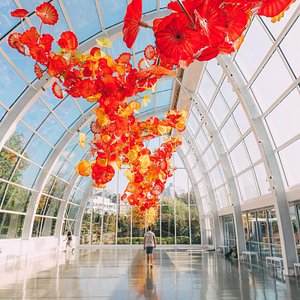
Outdoor Activities
What travellers are saying.
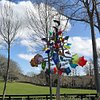

Spending a Day in Mount Vernon, Washington
Home » Spending a Day in Mount Vernon, Washington
Established in 1889, Mount Vernon is a small city located 60 miles north of Seattle. Most visitors know Mount Vernon as home of the Skagit Valley Tulip Festival , held annually during spring in Skagit County. But there’s plenty to do here year-round. Mount Vernon’s historic downtown has seen extensive revitalization in recent years — its renovated riverwalk coupled with numerous small businesses and attractions will keep you occupied for the day or an entire weekend.
- 1 Ristretto Coffee
- 2 Skagit Valley Coop
- 3 Breweries
- 4 Valley Shine Distillery
- 5 Get Outside
- 6 Relax With a Massage
- 8 Explore Beyond Mount Vernon
Ristretto Coffee
Start your day with a cup of joe from Ristretto Coffee Lounge & Wine Bar in the heart of the city of Mount Vernon, Washington. This cozy, European-style cafe serves coffee creations and breakfast all day. Wine, beer and cider are served alongside lunch options in the afternoon. Whenever you visit, Ristretto is a relaxing and comfortable place to read, work, or meet up with friends.
Skagit Valley Coop
For some of the best food in town, don’t miss the Skagit Valley Coop . The Coop itself is a market where you can find everything from fresh produce and baked goods to a busy deli counter. Stop here for lunch on-the-go (soups, salads, sandwiches). If you’d prefer a sit-down restaurant experience, head over to the Coop’s C-Square and Third Street Cafe . Here you’ll find a delicious farm-to-table menu, weekend brunch, and happy hour daily. All products are sourced as locally as possible, including the curated beer and cider tap list.

The City of Mount Vernon, WA is also an up-and-coming beer destination.For many years there has only been one brewpub in downtown, Skagit River Brewery . That changed when two new breweries opened in 2020. District Brewing is now open on the riverwalk in the historic Lyric Theater building. Temperate Habits Brewing opened recently as well, conveniently located downtown between Skagit River Brewery and District Brewing.
Outside of downtown, North Sound Brewing and Farmstrong Brewing are worth the drive to round out your tour de brew. Both breweries have sunny outdoor patios during summer. For more local beer, check out Skagit Beer Week in the spring.
Valley Shine Distillery
Walking into Valley Shine Distillery , the first thing you notice is its grand facade. The massive double doors — flanked by attractive wood paneling and 100-year old brick walls — offer a taste of what to expect inside: quality and craftsmanship. You’ll find fun food options alongside craft spirits and cocktails in their family-friendly tasting room.

Get Outside
The easiest way to get outside in Mount Vernon is by strolling along its riverwalk. Walk any downtown street west to the Skagit River, where a wide promenade offers riverfront views. During summer, a lively concert series is held at the Riverwalk Plaza. This area also hosts the Mount Vernon Farmers Market , held Saturdays between May and October.

For more of a workout, drive 10 minutes out of downtown to Little Mountain Park . Featuring over 500 acres of forest and miles of volunteer-built trails, Little Mountain is Mount Vernon’s outdoor playground. You can hike, trail run, mountain bike, or simply walk the dog here. Those not looking for a workout can drive to the top of Little Mountain for birdseye Skagit Valley views from two overlooks.
Relax With a Massage
After your workout (or anytime, really), treat yourself to a massage. Calm Water Massage is conveniently located in downtown Mount Vernon’s Pine Square. Their relaxing environment combined with experienced therapists makes for a winning combination: Calm Water Massage has won the “Best of Skagit” award nine years in a row.

Rainy day? If you’re looking for entertainment , Mount Vernon is home to two unique theaters. The historic Lincoln Theater was built in 1926 as a vaudeville & silent movie house. Today it hosts concerts, films and events in the center of downtown Mount Vernon. For theater, dance, live music and more, head to McIntyre Hall — the modern performing arts center at Skagit Valley College.
Explore Beyond Mount Vernon
To see more of the Skagit Valley, take a day trip from the city of Mount Vernon. The nearby waterfront towns of La Conner and Anacortes offer endless options for dining, drinks, shops and recreation.
Brandon Fralic
[…] nearby Mount Vernon, La Conner is a hot spot during the Skagit Valley Tulip Festival. If you’re visiting during the […]
[…] for a great photo op. One of the most iconic tulip farms to visit in the area is Tulip Town in Mt. Vernon. When the original owners of this deeply loved family-run farm retired after 36 years in 2019, five […]
Leave a Comment Cancel Reply
This site uses Akismet to reduce spam. Learn how your comment data is processed .
Privacy Overview

Our Visitors Information Center helps tourists and locals alike find the best Mount Vernon and the Skagit Valley.
Learn more about visiting Mount Vernon here .
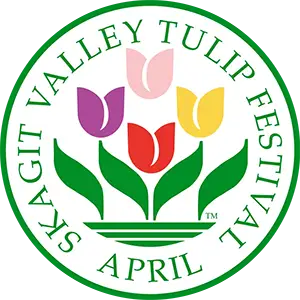
Skagit Valley Tulip Festival
spring 2024
Bloom Information
Weather information, places to stay.

Stay in the know with our Bloom Status – your reliable source for the latest updates on Skagit Valley’s tulip blooms. From bud development to full bloom, we keep you informed on the progress of the tulip blossoms.
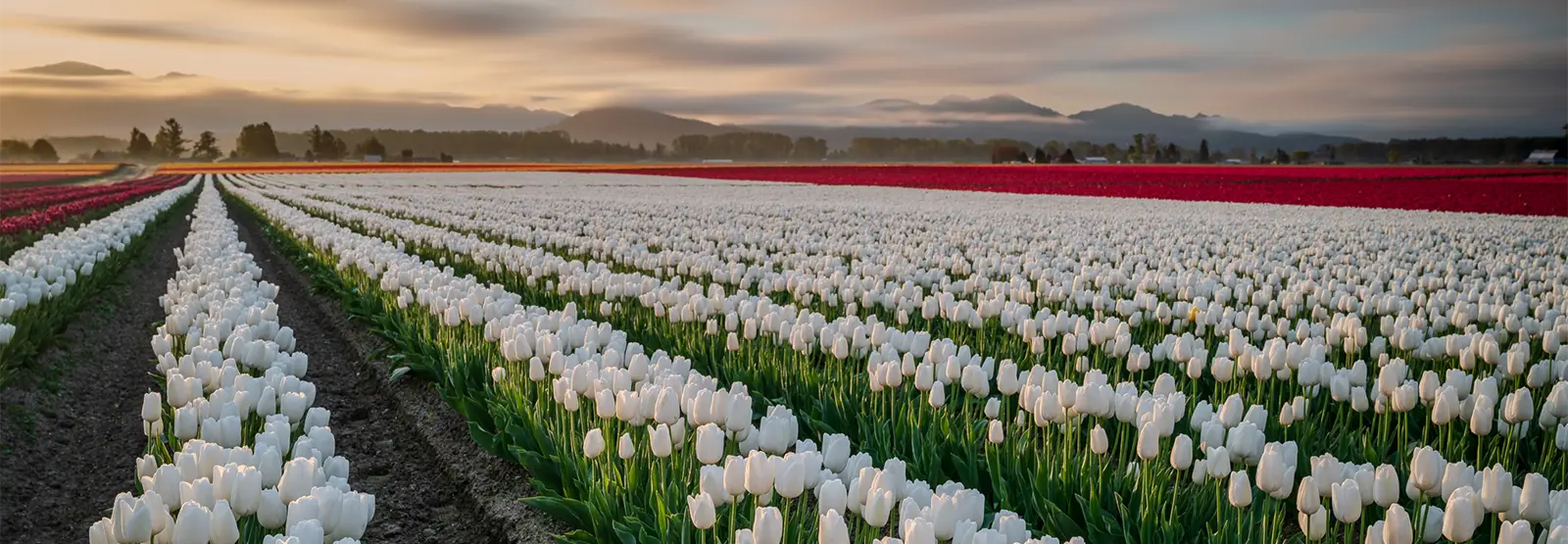
The Tulip Gardens
From meticulously curated landscapes to diverse tulip varieties, explore the unique charm each garden brings to the skagit valley tulip festival..
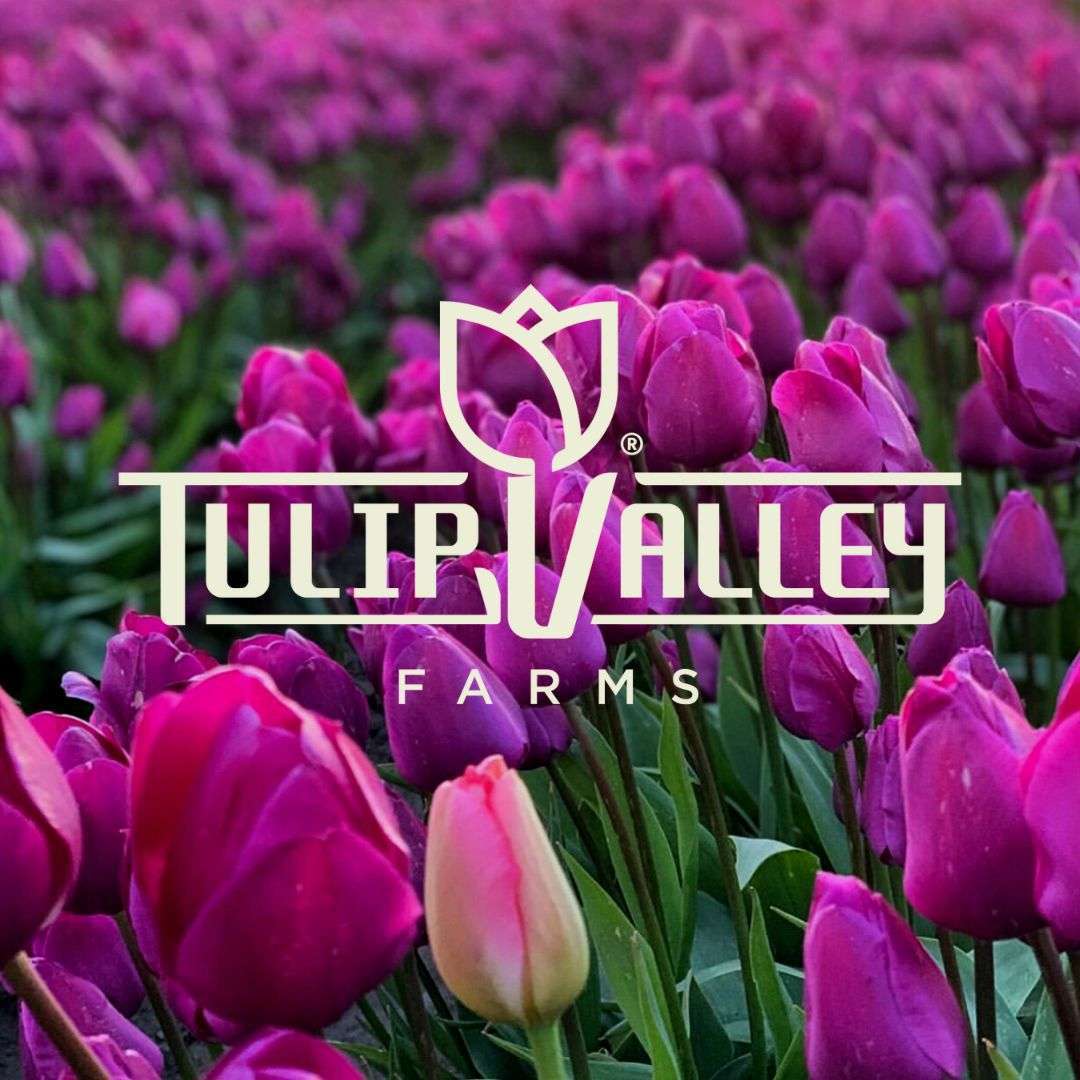
Activities For All Ages
Whether you are a sports enthusiast, music lover, art connoisseur, or someone seeking family-friendly fun, our festival has a little bit of everything for everyone. From the one of a kind Paccar Open House featuring test labs for semi-trucks to the vibrant street fair, the spirited Pickleball Tournament to captivating Art Shows, there's an activity for every passion. Plan your visit for the only Washington Tulip Festival and let the festivities unfold!
Festival Faves
Our top festival selections for memorable moments.
Discover the essence of Skagit Valley through our curated selection of cherished local businesses that add flavor and flair to the Skagit Valley Tulip Festival experience. This week, we’re highlighting 5 of our favorite places to eat.

ON THE BLOG:
Stay updated on festival happenings, tips for the perfect visit, behind-the-scenes stories, local highlights, and more.

Calling all photographers: 2024 Skagit Valley Tulip Festival Photo Contest presented by North Coast Credit Union
Apr 3, 2024
Celebrate Spring with the 2024 Skagit Valley Tulip Festival Photo Contest! We are thrilled to announce the 2024 Skagit Valley Tulip Festival Photo Contest, aimed at capturing the essence of our...

2024 Annual Skagit Valley Tulip Festival Gala Fundraiser
Mar 7, 2024
An Evening of Community and Giving! We're thrilled to extend a special invitation to our local community members to our annual Tulip Festival Gala, this year boasting the theme of 'Roaring 20's'....

Join the Fun at the 37th Annual Tulip Parade
Feb 28, 2024
Spring is approaching, and our excitement is blooming for the 37th Annual Kiwanis Club of La Conner Not So Impromptu Tulip Parade, proudly sponsored by Astound Broadband! Mark your calendars for...
Tulip Tidings
Catch up on the latest news on the Tulip Festival and community events throughout the year.
Our Sponsors
Thank you for making the festival possible.

Some of our Sponsors
Financial support for the festival comes from city and county governments and private sponsors..

Elevate your brand while supporting one of the Pacific Northwest's most iconic events.
Explore partnership benefits and join us in cultivating unforgettable experiences for visitors from around the globe. let's bloom together.


- THINGS TO DO
- Getting Here
- Electric Vehicle Charge Stations

Skagit Valley Tulip Festival
Skagit Valley Tulip Festival is the largest tulip festival in the USA by acreage of tulips, number of farms, and days of blooms. It is held annually in April and features fields of tulips, display gardens, experiences, and events. Historically, the tulip was a symbol of paradise on Earth. We welcome you to our modern-day paradise on earth, the Magic Skagit Valley, where millions of tulips burst into bloom in April during the Annual Skagit Valley Tulip Festival!
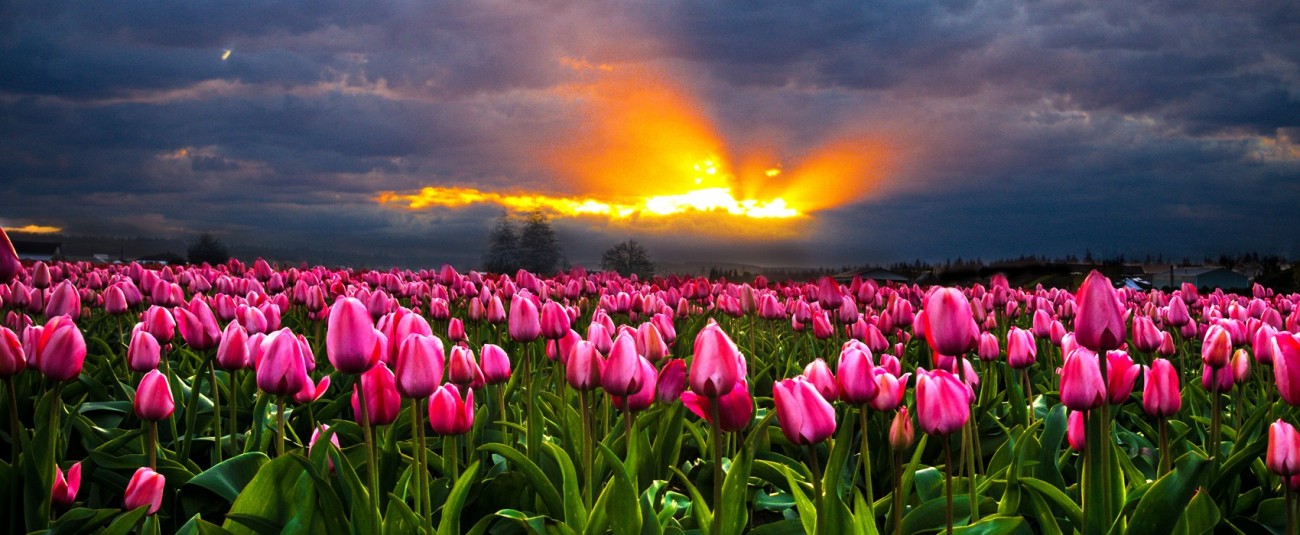
photo credit: Pam Headridge
Skagit Valley Tulip Festival features four farms: RoozenGaarde, Tulip Town, Tulip Valley Farms, and Garden Rosalyn. Skagit Valley bulb growers invite visitors to take a scenic drive through the Valley and experience the art of farming during the Skagit Valley Tulip Festival and throughout the year. Did you know that agriculture is the No. 1 industry in Skagit County? More tulip and daffodil bulbs are produced here than in any other county in the U.S., and local farmers produce about $261 million worth of 90 different crops, livestock, and dairy products on 93,000 acres of land. In addition to food and fiber products, agriculture in the Skagit Valley provides habitat for thousands of swans, snow geese, and dabbling ducks.
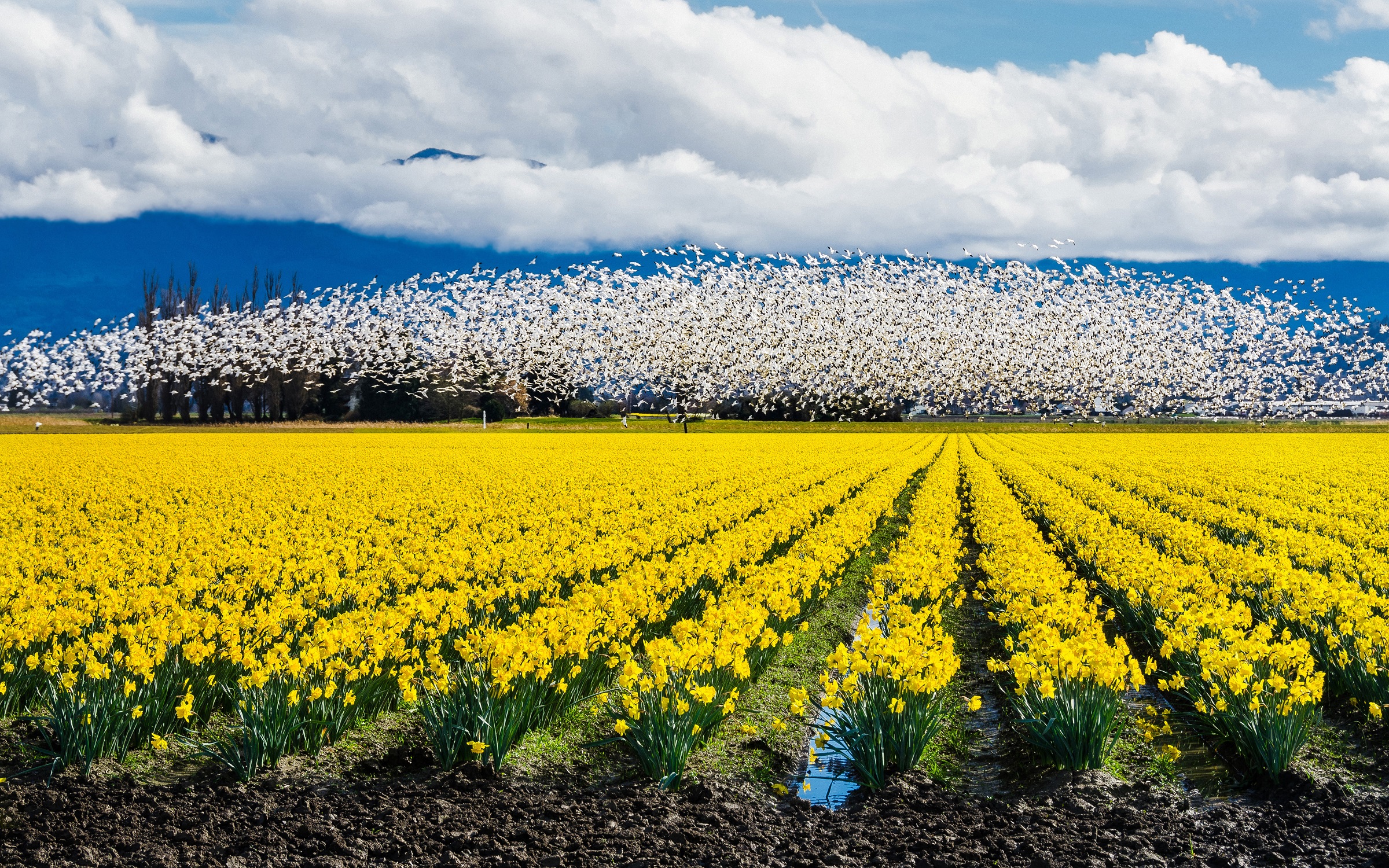
Daffodils & Snowgeese by Pam Headridge
Skagit Valley Tulip Festival Bloom Map
“When do the tulip blooms” “Are the tulips blooming yet” or “When does the Skagit Valley Tulip Festival begin” are some of the most popular questions we receive. Mother Nature decides on the exact dates for the tulips to bloom, but the Skagit Valley Tulip Festival experiences and events start on April 1st and last throughout April. Follow @skagitvalleytulipfestival and @visitskagit for the latest updates!
SKAGIT VALLEY TULIP FESTIVAL PASSPORT
Experience the best of the Skagit Valley Tulip Festival with the new Skagit Valley Tulip Festival Passport.
CLICK HERE FOR PASSPORTS
This exclusive mobile passport is a curated collection of Tulip Festival attractions, retailers, restaurants, and more, offering check-ins or deals and discounts to redeem during your Skagit Valley visit. Your passport will be instantly delivered to your phone via text and email and is ready to use immediately! There is no app to download. Your pass can be saved to your phone’s home screen for easy one-tap access. When visiting a participating location, check in using your phone’s built-in GPS and record your visit to count towards earning prizes!
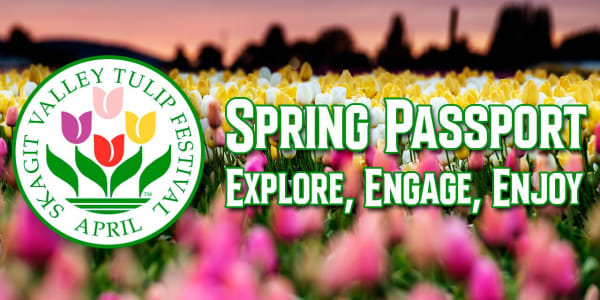
SKAGIT VALLEY TULIP FESTIVAL FARMS & GARDENS MAP
Click on the arrow to the left of the Skagit Valley logo to see the list of the Skagit Valley Tulip Festival Farms and Gardens.
Skagit Valley Tulip Festival Farms
Tulip valley farms.
Enjoy a tulip experience in a parklike 12 acres of color at Tulip Valley Farm on Bradshaw Road. Tulip Valley Farm features over 10 miles of grass “Tulip Trails” with iconic views of the North Cascades and Olympics and the only u-pick tulip field at the festival. Enjoy and savor an eclectic assortment of food trucks and a beer, wine, and cider garden. There will be photo opportunities with Mother Nature on her Springdom Throne and U-Pick bouquets on “Tulip Island.” At night, be prepared for the Night Bloom, a light show and explosion of spring color after the sun goes down!
Tulip Valley Farms has 5 acres of free parking, weekday/family discounts, and ticket bundles. For a more intimate experience, pre-order tickets to Tulip Valley Gardens on Pulver Road, right off I-5 and Highway 20! You can choose from unique experiences like Tea Time in the Tulips, Guided Painting Class, Magical Boutique, Professional mini photo sessions, and u-pick.
PURCHASE TICKETS HERE
Tulip Town has a variety of ticket levels this upcoming season, including; General Admission, Anytime, Anytime Plus, Experience Pass, and Photography Pass. Open Monday-Thursday from 10 – 6 and Friday – Sunday from 9 -7, general admission includes parking, an old-school trolley ride through the tulips (weather-dependent), a beautiful outdoor garden and indoor mural displays, Tulip Town’s retail boutique, and a flower stand with bouquets and potted tulips. Enjoy food, treats, and specialty espresso drinks from the Skagit Landing Cafe. Tulip Town Beer & Wine Garden offers local Skagit beer, wine, and cider.
Tulip Town now allows dogs. Dogs will be allowed with any ticket level except the Experience Pass. Tulip Town requires dogs to remain on a short leash, be picked up after, and be well-behaved around people and other dogs. Tulip Town does not allow drones.
When purchasing online, general admission is $15 for ages 12+, $7 for ages 6-11, and $13 for Seniors/Military, and kids five and under are free. Ticket prices will be higher at the gate. For details on all the admission options, please visit Tulip Town’s online ticket sales:
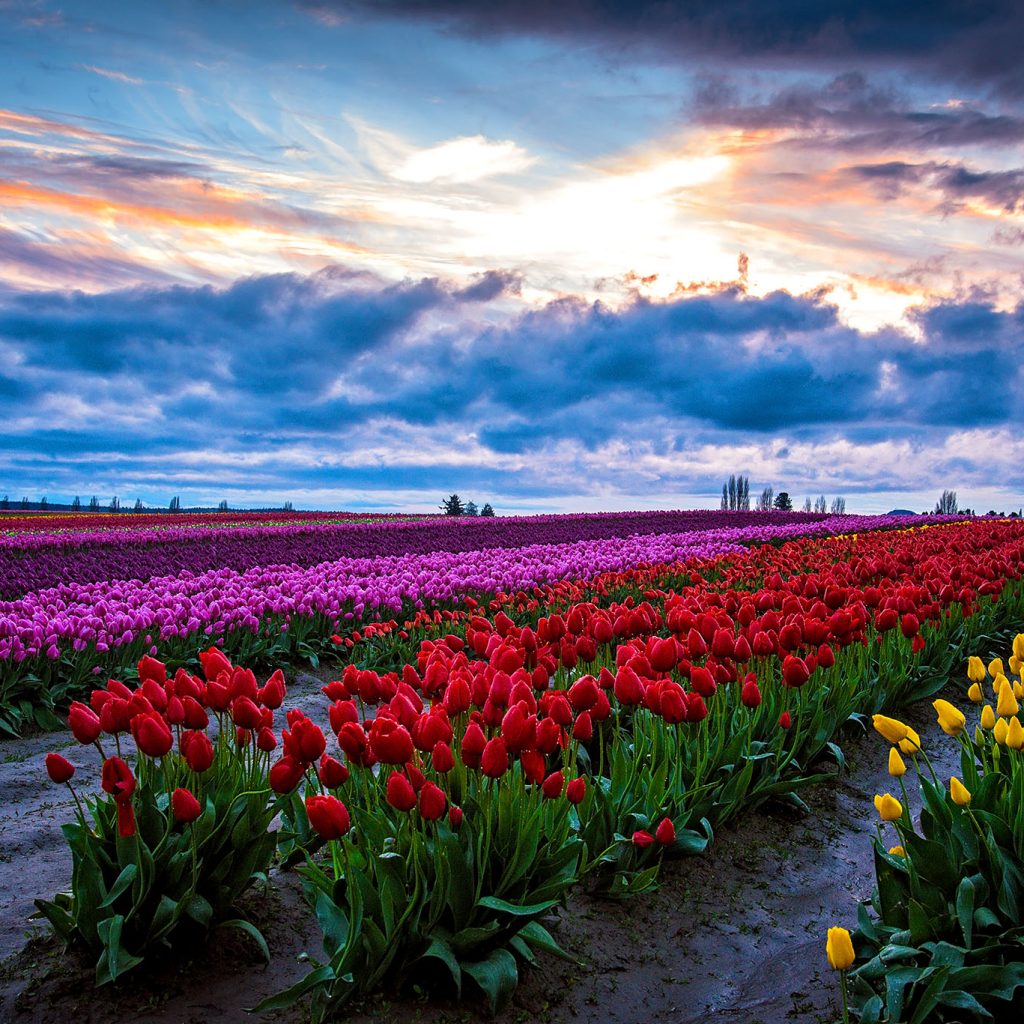
photo by pam headridge
ROOZENGAARDE
RoozenGaarde offers General Admission tickets for $15 per person, with children ages two and under free from 9 AM – 7 PM on weekdays and 8 AM – 7 PM on weekends. The General Admission tickets include access to the RoozenGaarde’s 5-acre display garden, a 25-acre tulip field, and a 25-acre daffodil field. The RoozenGaarde Gift Shop and Fresh Cut Tulip Market will be open. The gift shop hours during the Skagit Valley Tulip Festival are 9-7, and RoozenGaarde closes 10 minutes after sunset. RoozenGaarde does not allow pets or drones.
GARDEN ROSALYN
Garden Rosalyn features acres of tulips in intricate designs. Enjoy picnic tables and on-site food trucks. Well-behaved dogs on leashes are welcome! Admission is $12 and children five and under are free. Parking is free. Garden Rosalyn is located at 16648 Jungquist Rd, Mount Vernon, WA. You can give them a call at 360-202-7982.
Skagit Valley Tulip Festival Photo Contest
Celebrate Spring with the 2024 Skagit Valley Tulip Festival Photo Contest aimed at capturing the essence of our beautiful Skagit Valley while fostering community engagement. Presented in partnership with North Coast Credit Union, the contest invites photographers of all levels to showcase their creativity and skill through captivating imagery.
Skagit Valley Tulip Festival FAQ
Q: Where is the Skagit Valley Tulip Festival held? A: The Skagit Valley Tulip Festival is designed as a driving tour. There is no one location, but there are four Tulip Farms and Growers you do not want to miss. The tulip fields are centrally located between La Conner and Mount Vernon. Events and happenings are all around Skagit Valley. The tulip fields are the crops of RoozenGaarde/Washington Bulb Co., Inc., Tulip Town, and Tulip Valley Farms. Because of crop rotation, the tulip fields are different each year. RoozenGaarde, Tulip Town, Tulip Valley Farms, and Garden Rosalyn also have displays of tulips in gardens for visitors to view and photograph. All the tulip bulb growers charge admission and have free parking.
Q: How do you buy tickets to the gardens? A: Tulip Town, Roozengaarde, Tulip Valley Farms, and Garden Rosalyn tickets are available online. See Skagit Valley Tulip Festival Farms above for links to purchase tickets.
Q: Can I drive by and look at fields without purchasing tickets? A: Tulip Fields: Drive-by 24/7, located between La Conner and Mount Vernon .
Q: Are the tulips blooming yet? When is the best time to view the tulips? A: Mother Nature decides on the exact dates for tulips to bloom. Keep an eye on the Bloom Map and follow us on Facebook and Instagram for updates! The Tulip Festival runs the entire month of April. The least crowded times are weekdays, early mornings, and late afternoons. Weekends are busy – your best experience will be booking a Lodging Option in Skagit Valley and driving by the fields in the early morning or late afternoon.
Q: What date is the Tulip Festival? A: The Tulip Festival is held from April 1-30 annually. However, mother nature determines when the tulips bloom. Some years the tulips bloom the last week of March, and in other years they may not bloom until the second week of April. Also, different varieties of tulips bloom earlier and later. The La Conner Daffodil Festival features the first blooms of Daffodils in March.
Q: I would like to start planning my trip to the Skagit Valley Tulip Festival – Where is a list of events? A: The Skagit Valley Tulip Festival brochure will be ready in January. Click here for the Skagit Valley Tulip Festival 2024 brochure.
Q: How much does it cost to go to the Tulip Festival? A: To view the fields as you are driving by is free, but to enter Tulip Town, Roozengaarde, Tulip Valley Farms, and Garden Rosalyn, see above regarding tickets.
Q: What time does the Tulip Festival open? A: You can view the tulip fields at any time! However, each bulb grower has different hours for the display gardens. See above for each garden display hours.
Q: Is the Skagit Valley Tulip Festival kid-friendly? Are there activities or events for children? A: Yes! Here is a great blog post regarding Tulip Festival Activities For Kids .
Q: How accessible is the Tulip Festival? A: All four display gardens offer Disabled Parking. Roozengaarde display garden’s have level gravel paths, and Tulip Town’s indoor facility and display garden are easily accessible. Garden Rosalyn offers a vista to view the garden, but the property is sloped.
Q: Are there Tulip Festival Tours available? Or other tours? A: Yes – check out our list of Tulip Festival Tours . If you enjoy tours, check out our other Skagit Tours offerings, including whale watching and Deception Pass boat tours. If you prefer a self-guided tour outside the tulip world, check out our guided maps , the self-guided Skagit Farm to Pint Ale Trail , and the Skagit Food Trail . Still up for more? Check out Things To Do in Skagit County.
Q: Is it possible to ride our bikes, and are bike paths alongside the fields? Yes! All the roads are nice and flat around the tulip fields, and almost all have shoulders to ride on. Check out the Skagit County Bike Map for routes and the Skagit Food Trail for information on e-bikes in La Conner.
Q: Can I pull over to take pictures of the tulip fields? A: You will see no parking signs on the roads next to the fields. Because of safety reasons, please use a parking area.
Q: Can you bring your dogs to the Tulip Festival? A: Tulip Town and Garden Rosalyn allow well-behaved dogs on leashes.
Q: How do I get there – Directions? A: Take I-5 North from Seattle or I-5 South from Vancouver, BC. Depending on what direction you are heading and what fields you want to view, use the Tulip Festival map to pick your exit. You will be heading West from I-5.
Q: I’m from Canada – Can we take cut blooms back over the border? What about bulbs? A: Yes – you can take cut tulip blooms over the border. However, bulbs are unavailable for purchase during the tulip festival as they are in the ground but can be shipped to Canada in the fall.
Q: Is there a printable map and listing of all the events? A: Yes. You can view the printed map in the Skagit Valley Festival Brochure. 2024 Brochure
Q: When Do Tulips Bloom? A: Skagit Valley tulips have been farmed here since the early 1900s. Today the “field tulips” are the crops of the Washington Bulb Co., Inc/RoozenGaarde, Tulip Town, and Tulip Valley Farms. The field tulips bloom in April, but the weather determines exactly when. Check bloom status at the BLOOM MAP, call the Tulip Festival office at 360.428.5959, and visit our Instagram and Facebook pages. Tulip crops rotate, so that you will need a new map each year.
Q: Where do I Park for the Tulip Festival? A: Decide which gardens you are going to visit, purchase tickets and follow their directions for parking.
Q: Is there Private Parking at the Tulip Festival? Landowners sometimes charge for parking. The money you pay cannot be used for admission or other parking.
Q: Can I park on the shoulder to view the tulips? A: This parking is very limited. Sheriff’s officers will issue tickets.
Q: Can I bring my drone to the Tulip Festival? A: Drones are not allowed in the gardens or the fields.
Q: I’m a professional photographer – Do I need to credit RoozenGaarde to publish photographs of the display garden or fields? A: Please sign the Tulip Festival Photo Release Form and return it to the Roozengaarde (Washington Bulb Co.) office. Tulip Town has special Photography Passes, and Tulip Valley Farms has professional mini-photo sessions.
Q: I’m a tour bus operator – Do I need to fill out a reservation form for bus parking? A: Yes – please fill out the Tulip Festival Bus Reservation Form.
Q: What is the difference between RoozenGaarde, Tulip Town, and Tulip Valley Farm? A: RoozenGaarde has display gardens and a gift shop and does not allow dogs. Tulip Town has a trolley ride through the tulip fields, a display garden, a gift shop, food, espresso, a beer and wine garden, and allows dogs. Our newest Tulip grower – Tulip Valley Farms, has grass trails through the tulips, food, beer & wine, a night show, and u-pick, and offers experiences such as tea time in the tulips, guided painting class, and professional mini photo sessions.
Q: What else is there to do in Skagit Valley in the spring? A: Check out our driving itinerary and video for a Spring Skagit Road Trip! A: Check out the Skagit Food Trail A: Check out Skagit Farm to Pint Ale Trail A: Explore our website!
The Skagit Valley Tulip Festival is Magic Skagit at its finest! The Magic Skagit Valley’s natural wonders include the Salish Sea shorelines, bays, islands, mountains, the Skagit River, and one of the largest and most diverse agricultural communities west of the Cascade mountain range. See why the rest of the world agrees that Skagit Valley is magical! Thank you for visiting the Magic Skagit Valley!
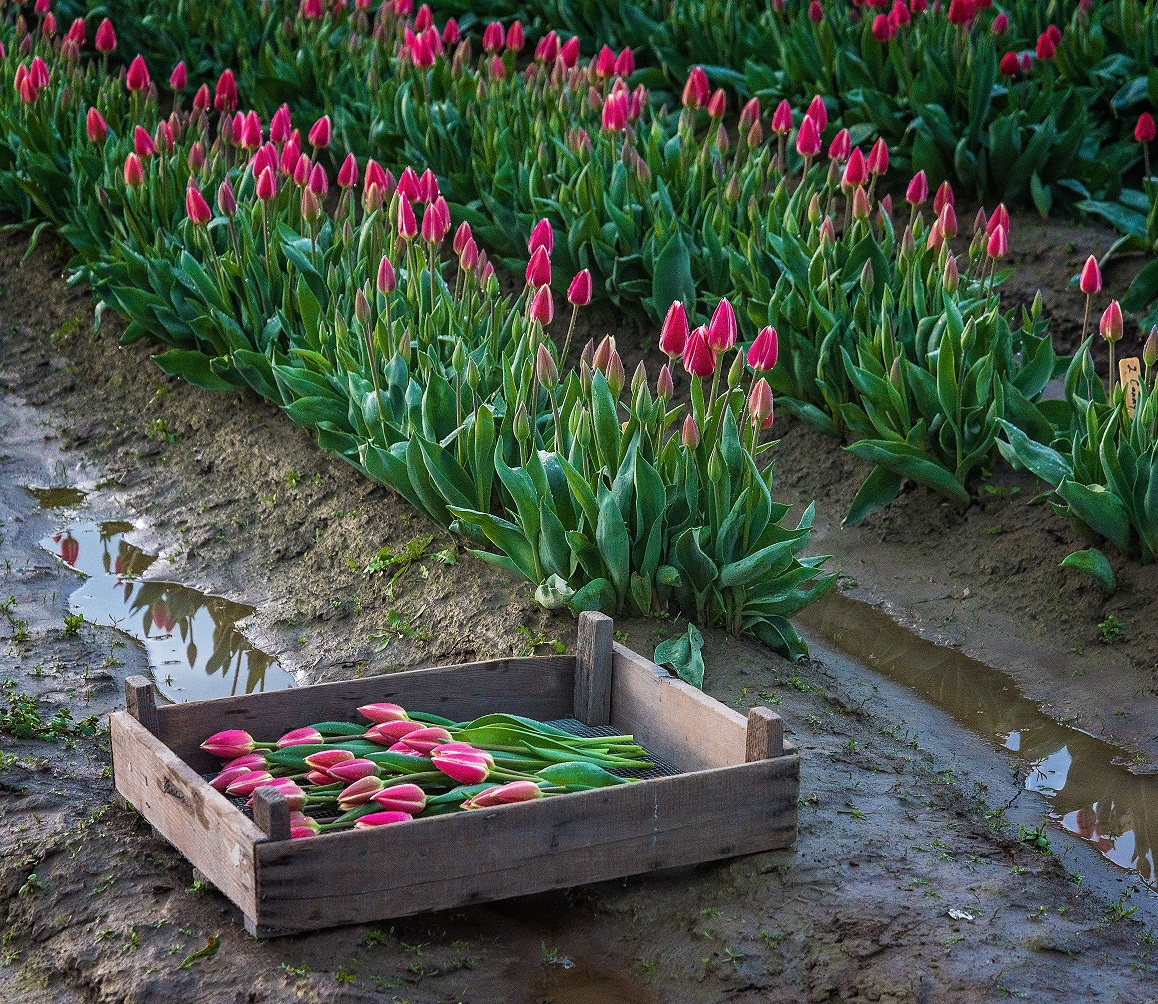
photo credit: pam headridge
Skagit Valley Tulip History
The popularity of tulips in Skagit Valley can be traced to Mary Stewart who traveled west with her husband from Ohio in 1903 in search of better weather. They settled on 40 acres of timberland on Samish Island. In memory of her mother, Mary decided to grow some tulips as her mother did back East. Stewart recalled that when her first bulb delivery came from Holland by boat, half the town turned out to see it. Later, Mary Stewart had a thriving mail order business selling bulbs to garden clubs. By 1930, the Stewarts had outgrown their 40 acres and expanded 5 miles northeast of La Conner. Seven years later, they had the biggest bulb farm in Skagit which included 40 acres of tulips, 80 scares of daffodils and 25 acres of irises. Thank you, Mary Stewart, for starting a lasting tradition of tulips in the Valley!
Search the Website
- Skip to primary navigation
- Skip to main content
- Skip to primary sidebar
- Skip to footer
TravelAwaits
Our mission is to serve the 50+ traveler who's ready to cross a few items off their bucket list.
A Visit To Mount Vernon: The Best Things To See And Do

Orhan Cam / Shutterstock
- Activities and Interests
- Destinations
- History and Culture
- United States
- Washington, D.C.
With his proven success leading a ragtag group of patriots to win the Revolutionary War and drafting the constitution of the newly formed United States, George Washington steadfastly secured his place in history as America’s first president. And that’s why, in a city full of free memorials, museums, and other sights, it’s absolutely worth the time, effort, and cost to travel about 15 miles south of the nation’s capital to spend a day at Mount Vernon.
From the mansion where America’s first president lived to the slave cemetery a few feet away from the graves of George and Martha, these are the best things to see and do on a visit to this Founding Father’s home in Mount Vernon.

Sage Scott / Everyday Wanderer
George Washington’s Mansion
When George was a toddler, his father began building a modest home. And when the future president’s older half-brother passed away two decades later, a 22-year-old George took the reins. Over the next 45 years that Washington lived at Mount Vernon, he added to the home, turning it into the nearly 11,000 square foot, two-and-a-half-story, 21-room mansion that can be toured today.
General admission to Mount Vernon includes a guided tour of the mansion. However, entrance to the mansion is timed, so it’s best to purchase your tickets in advance and plan the rest of your visit to Mount Vernon around your scheduled home tour.
There is a lot to take in when touring the home, which is ten times larger than the average colonial Virginia home. However, your tour guide will certainly tell you all about:
- The majestic New Room (including how it got its name)
- George Washington’s study (his 18th-century man cave)
- The Washingtons’ bedroom (where George passed away from a throat infection in 1799)
- The dove weathervane atop the cupola (commissioned by Washington to symbolize his desire for peace in the new nation)
But one of my favorite experiences was learning about a key mounted on the wall of the central hall. The key was a gift from the Marquis de Lafayette, Washington’s friend and fellow revolutionary. It once unlocked the door to the infamous Bastille prison, whose destruction is considered the start of the French Revolution.
Pro Tip: To view the upper floors of the home, you’ll have to climb stairs. See the Mount Vernon website for accessibility information including recommended paths and handheld devices for guests with limited vision and hearing.

A Variety Of Outbuildings
In stark contrast to the mansion, be sure to visit the overseer’s and slave quarters. Because he was often away from Mount Vernon serving his country, George Washington hired an overseer for each of his five farms. In exchange for a modest annual salary of $133.33 — plus lodging, meals, and laundry service — the overseer at Mount Vernon was given the 18th-century equivalent of a studio apartment. And for a life of backbreaking forced labor, the hundreds of enslaved men, women, and children at Mount Vernon lived with 20 or more people in the same space.
In a world without indoor plumbing, the “necessary” was the Cadillac of outhouses back in the 18th century. Instead of a deep dirt hole where human waste would be deposited, the outdoor facilities at Mount Vernon used a system of drawers that could be removed for proper disposal and cleaning.
Other buildings to explore for a glimpse of life at George Washington’s Mount Vernon include the blacksmith shop, carriage house, stable, spinning house, and storehouse.

Gardens And Greenhouse
If you stand on George Washington’s front porch, you’ll see a large curved expanse of lush green grass known as the bowling green. While many of our homes feature green lawns today, in the late 1700s it was a rarity that reinforced the Washingtons’ wealth.
Flanking the bowling green are the upper garden (to the right) and the lower garden (to the left). The lower garden was designed to produce edibles for the kitchen, but the upper garden was created to grow flowers and be a place of beauty.
Speaking of beauty, it’s hard to miss the impressive red brick building with a row of cathedral glass windows that stands on the northeastern edge of the upper garden. In this massive greenhouse, the first president was able to successfully grow coffee beans, healing aloe plants, citrus trees, and other non-native plants through the cold Northern Virginia winters.

George Washington’s Final Resting Place
Since his death at the end of the 18th century, George Washington has been interred in two places at Mount Vernon. Overlooking the Potomac River, the old vault was the original burial plot for POTUS 1, his wife, and 20 other family members. But George Washington realized that the family vault required extensive repairs, so his last will and testament requested that a new tomb be constructed.
About three decades after his death, the bodies of America’s original president and first lady were moved to their current resting place. With two cream-colored obelisks that look like miniature Washington monuments, George and Martha are now buried in a small brick building just to the west of the old tomb.

Slave Cemetery And Memorial
While it’s a beautiful and historic place to visit, the truth is that George Washington’s Mount Vernon was constructed and operated by hundreds of enslaved men, women, and children . And although 12 American presidents owned slaves, several things set George Washington apart from other slave masters.
Despite the fact that he owned hundreds of human beings, George Washington struggled with the idea of slavery, spoke out against the institution, and expressed his desire to end the practice. And more importantly, he ultimately took action. In the will he penned in his home office, Washington stipulated that his slaves would be freed upon the death of his wife, Martha.
And when the Mount Vernon Ladies’ Association identified the location of the slave cemetery in 1929 by adding a memorial marker — just steps from where George and Martha are buried — it was believed to be the first tribute of its kind at an American historic site. In 1983, architecture students from Howard University added an updated memorial to the Slave Cemetery to honor the enslaved people who were forced to spend their lives toiling at Mount Vernon.

MountVernon.org
Mount Vernon Inn Restaurant
While you can certainly dodge scores of school children and opt for a fast-food style meal at the Mount Vernon Food Court Pavilion, there is an alternative, and I highly recommend it! For just a few dollars more, you can enjoy a delicious sit-down meal at the Mount Vernon Inn Restaurant. No matter which salad, sandwich, or entree you select, be sure to add a cup of George’s favorite soup to your order.
Made with a recipe that dates back to George and Martha’s time at Mount Vernon, the peanut and chestnut soup is amazing, no matter how unusual it may sound.
Pro Tip: An admission ticket is not required to dine at the Mount Vernon Inn, so if your itinerary doesn’t allow you to spend a day exploring the estate, you can always stop by for dinner (and a cup of that amazing soup)!

Other Tips For A Fantastic Visit To Mount Vernon
While the D.C. Metro is an affordable, easy-to-navigate way to get around the capital city, getting to Mount Vernon without a car can be more challenging. Here’s how to get there via subway and bus from Washington, D.C .
In addition to a guided tour of George Washington’s mansion, access to the outbuildings, and entrance to the museums, your general admission ticket also includes access to the distillery and gristmill. If you visit between April 1 and October 31, these additional sights are a short shuttle ride from the main estate.
The best time for a visit to Mount Vernon is in the spring, summer, or fall, when you’ll be able to best admire the beauty of the grounds and see the animals.

D.C. Bound? Here are 10 things to know about the Cherry Blossom Festival , plus Hotel Vs. AirBnb: Where To Stay In Washington, D.C.

Bitten by the travel bug as a preschooler when her family moved abroad for the first time, Sage Scott is addicted to travel. From her nomadic upbringing in a military family to her personal and professional travels as an adult, Sage has visited all 50 states, lived abroad twice, and explored nearly 30 other countries.
Now settled in America’s Heartland, Sage writes with a midlife traveler’s perspective from Kansas City — the Midwestern cowtown affectionately called the Paris of the Plains and the undisputed Barbecue Capital of the World — and is always in search of new experiences whether in her hometown or halfway around the world.
Plan, Ready, Go®
Tips for Visiting Mount Vernon, George Washington’s Home
If you’re planning a trip to Virginia or Washington, D.C., Georgie Washington’s Mount Vernon should be on your list of places to visit. Here are some great tips for visiting Mount Vernon.
George Washington’s home is open to the public and offers a unique look into the life of the first president of the United States. Mount Vernon is one of my absolute favorite historic homes in the United States and certainly one of my favorite stops on any trip to the Washington, DC, area.
I’ve visited Mount Vernon many times. I hope you enjoy it as much as I do.
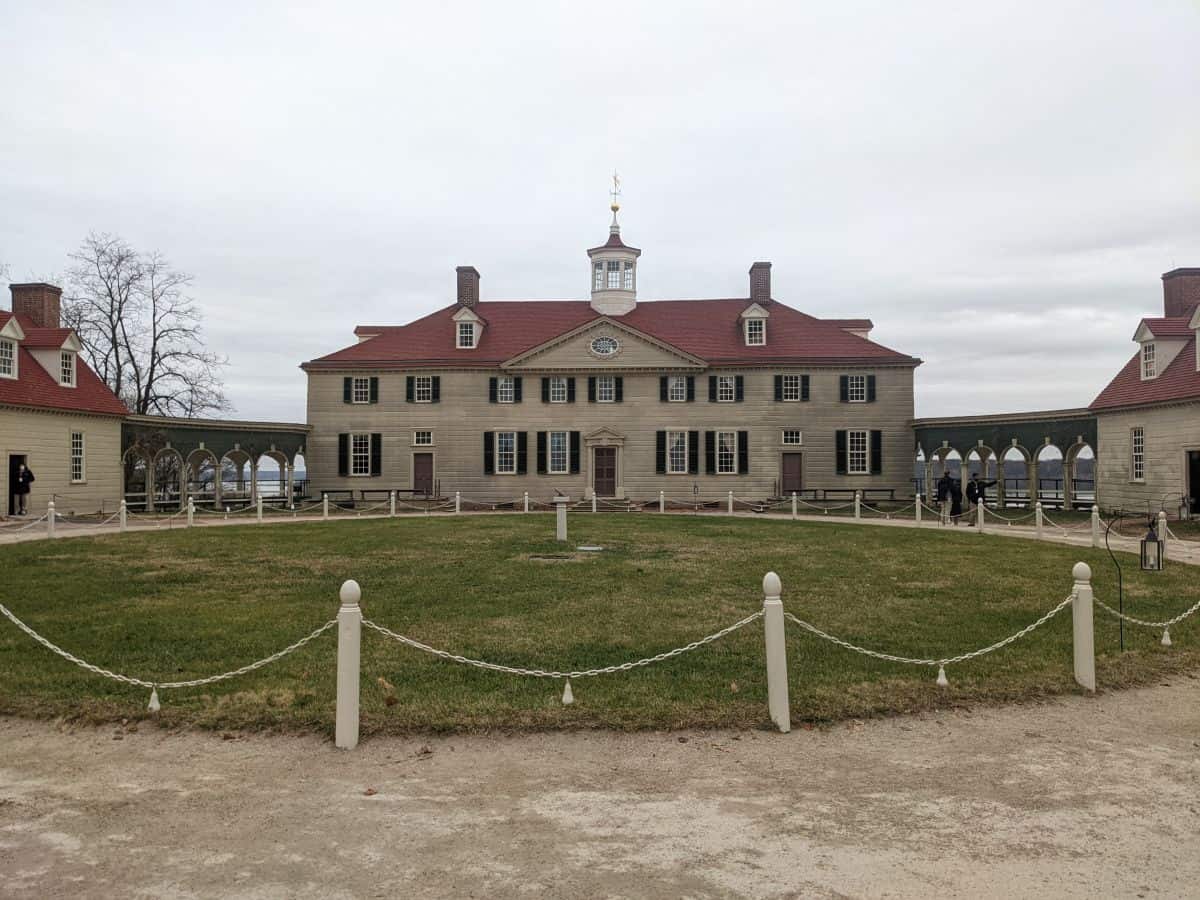
This post includes affiliate links. If you make a purchase through one of these links, I may earn a small commission at no additional cost to you. As an Amazon Associate, I earn from qualifying purchases. See disclaimer.
What is Mount Vernon?
Mount Vernon is a historic site located just outside of Washington, D.C. that was home to George Washington, the first president of the United States, and his wife Martha Washington.
The estate is managed by the Mount Vernon Ladies’ Association. Its preservation and restoration are privately funded. Mount Vernon was first open to the public in 1860, and it has since become one of the most visited historic sites in the United States .
Although George Washington’s land holdings were about 8,000 acres at one time, Mount Vernon is now about 500 acres.
Even if you’re not a history buff like me, a trip to Mount Vernon is definitely worth it. And it makes for a great day trip in Virginia or an addition to any family vacation in the area.
Where is Mount Vernon?
Mount Vernon is located in Northern Virginia a few miles south of Alexandria, Virginia, and a short drive from Washington, D.C. It’s a fairly easy drive to Mount Vernon and parking there is always free .
Getting to Mount Vernon from Washington, D.C. without a car is not easy, but it can be done. Using public transportation to get to Mount Vernon does require taking Metrorail and a Fairfax Connector bus.
Some tour operators offer round-trip cruises on the Potomac from Washington, DC, or Alexandria that stop at Mount Vernon and include admission tickets so you can explore the estate for a few hours.
PRO TIP: If you have flexible travel dates you need to check out Going (formerly Scott’s Cheap Flights). You get amazing flight deals sent straight to your inbox with instructions on how to book directly with the airlines. Check out Going here. Going is my favorite way to find great travel deals.

How much time should you plan to spend at Mount Vernon?
You’ll need at least a few hours to take in all the sights at Mount Vernon. I recommend planning to spend half a day or more if you want to make the most out of your visit.
Most visitors will spend between two and three hours exploring the grounds, but you can certainly spend more time if you’re interested in a deeper dive. Mount Vernon recommends planning on three hours , but you can spend less time and still see a lot if you want.
There’s so much to see and do at the estate (more on this below) that you’ll want to give yourself plenty of time to explore so that you don’t feel rushed.
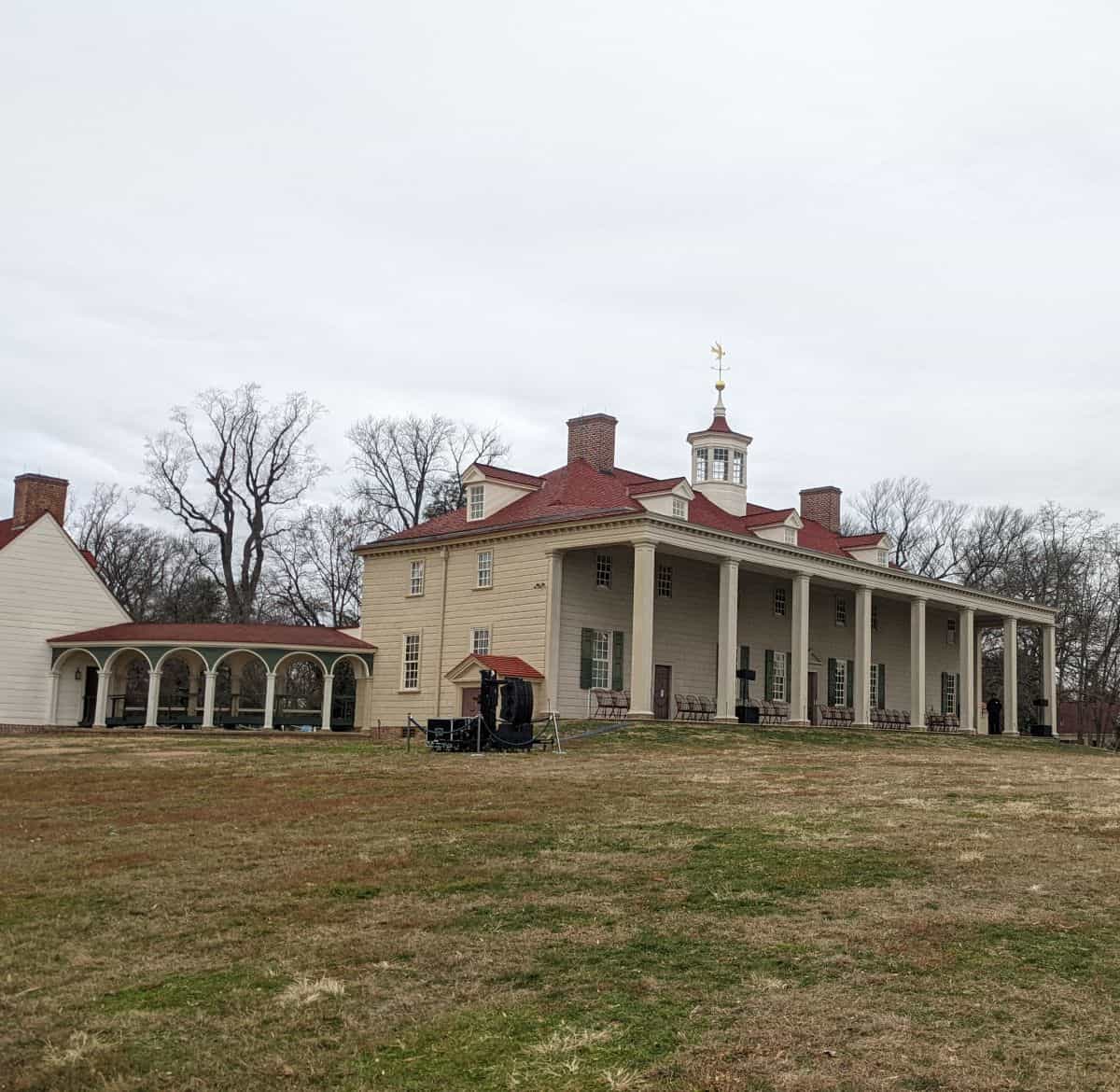
Tips for visiting Mount Vernon
When visiting Mount Vernon, there are a few tips to keep in mind.
First, you need to review your ticket options and decide which is best for you. I strongly recommend that you purchase your tickets in advance . You also want to make sure you understand which ticket you’re buying so you don’t miss out on touring the mansion if that’s really want to do.
Be sure to wear comfortable shoes as the estate and grounds are quite large and you’ll likely be doing a lot of walking. Also, you’ll want to know that some of the paths are dirt and/or uneven in places.
You’ll also be spending a lot of time outdoors, so make sure to check the weather forecast and plan appropriately.
Bringing water with you is a good idea , especially if temperatures are higher.
TIP: Keep track of all of your important travel details with a digital travel planner like this .
What to see at Mount Vernon
There are so many things to see and do at Mount Vernon that it can actually be a little overwhelming if you’ve never been there before. Below are what I think are the essential things to see at Mount Vernon.
Visitor Center (Ford Orientation Center)
On your trip to George Washington’s Mount Vernon, be sure to stop by the visitor center first. There, you can pick up a map of the estate, inquire about audio tours, and learn about all the different attractions there.
Oh, and this is also a good place to use the restroom. LOL.
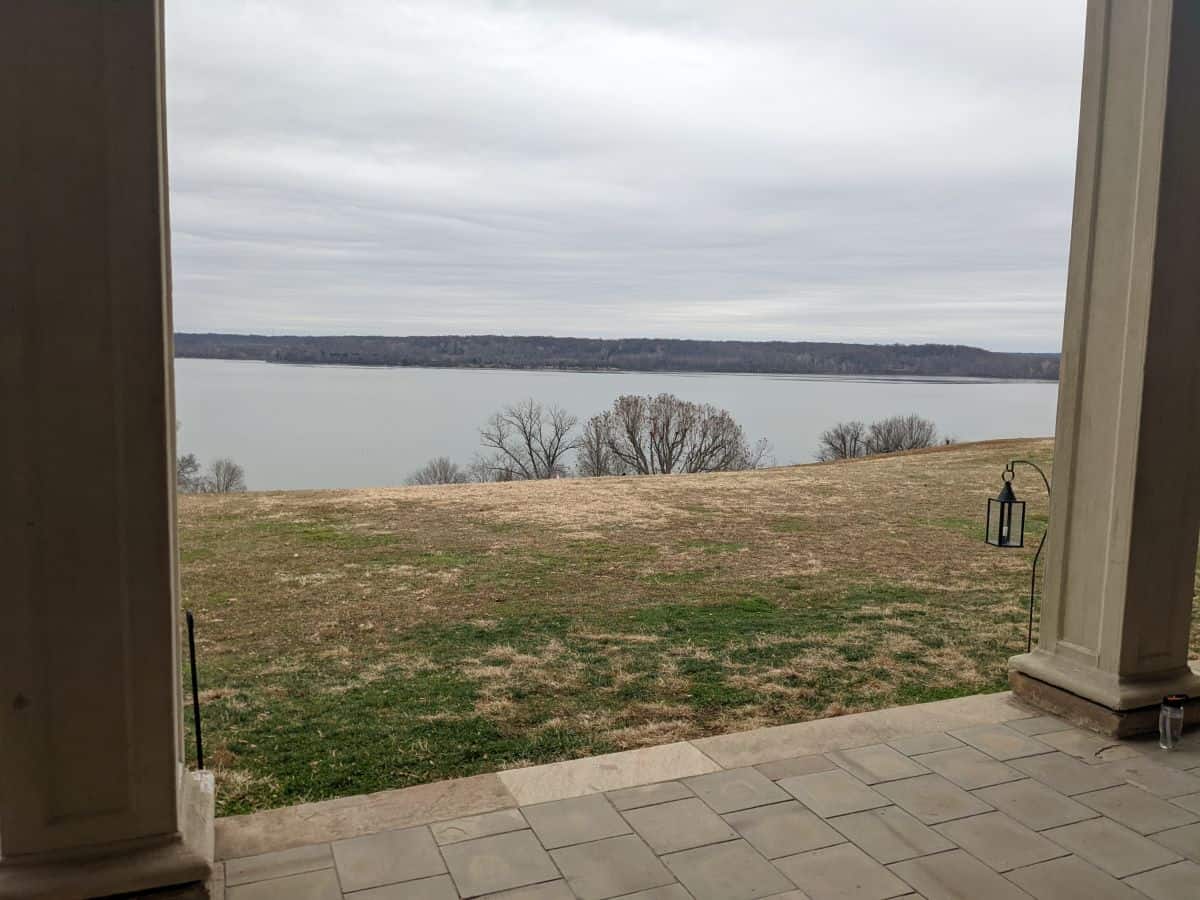

Mansion Tour
The mansion tour is one of the highlights of a visit to Mount Vernon. In my opinion, no first-time visitor to Mount Vernon should skip the opportunity to tour the inside of George Washington’s beautiful home.
The mansion tour is offered in addition to the general admission ticket and requires a booking.
Mount Vernon’s knowledgeable staff will guide you through the main house and answer any questions you have about George Washington’s home.
You’ll be taken through the home, including several important rooms on the lower floor like the dining room and George Washington’s private study. You’ll also get to learn about life at Mount Vernon during Washington’s time, as well as the history of the estate.
Please note: the mansion is currently undergoing a major restoration project that may impact your visit.
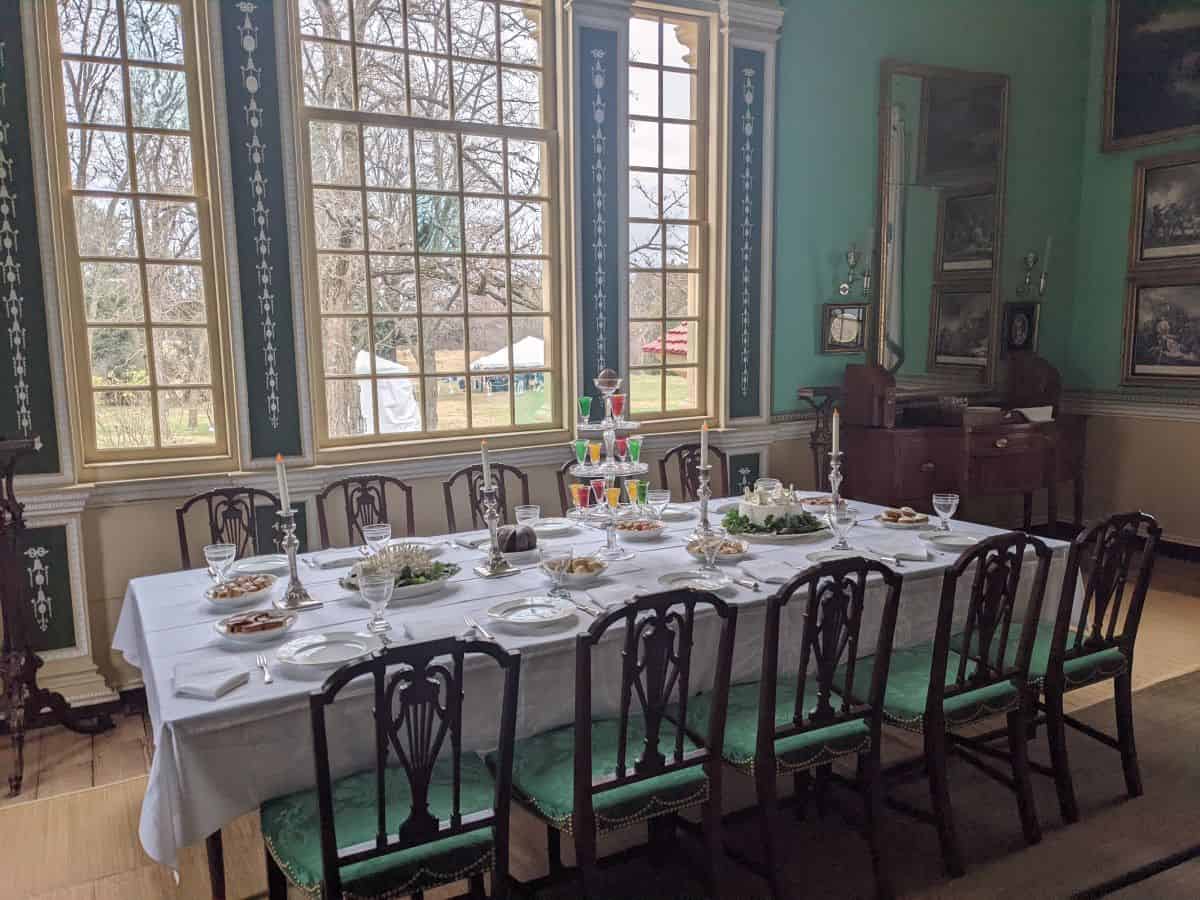
Our tour included a visit to the second-floor chamber where you could see the Washington’s bed chamber. It is the very room where George Washington died in 1799.
And make sure to spend some time on the east front of the mansion enjoying the view from its vantage point on the banks of the Potomac River. Your guided tour time on your ticket is the time at which you can get in line for your tour, though you may have to wait a bit before you actually get into the mansion.
You should plan to arrive at the estate at least 30 minutes before your mansion tour time.
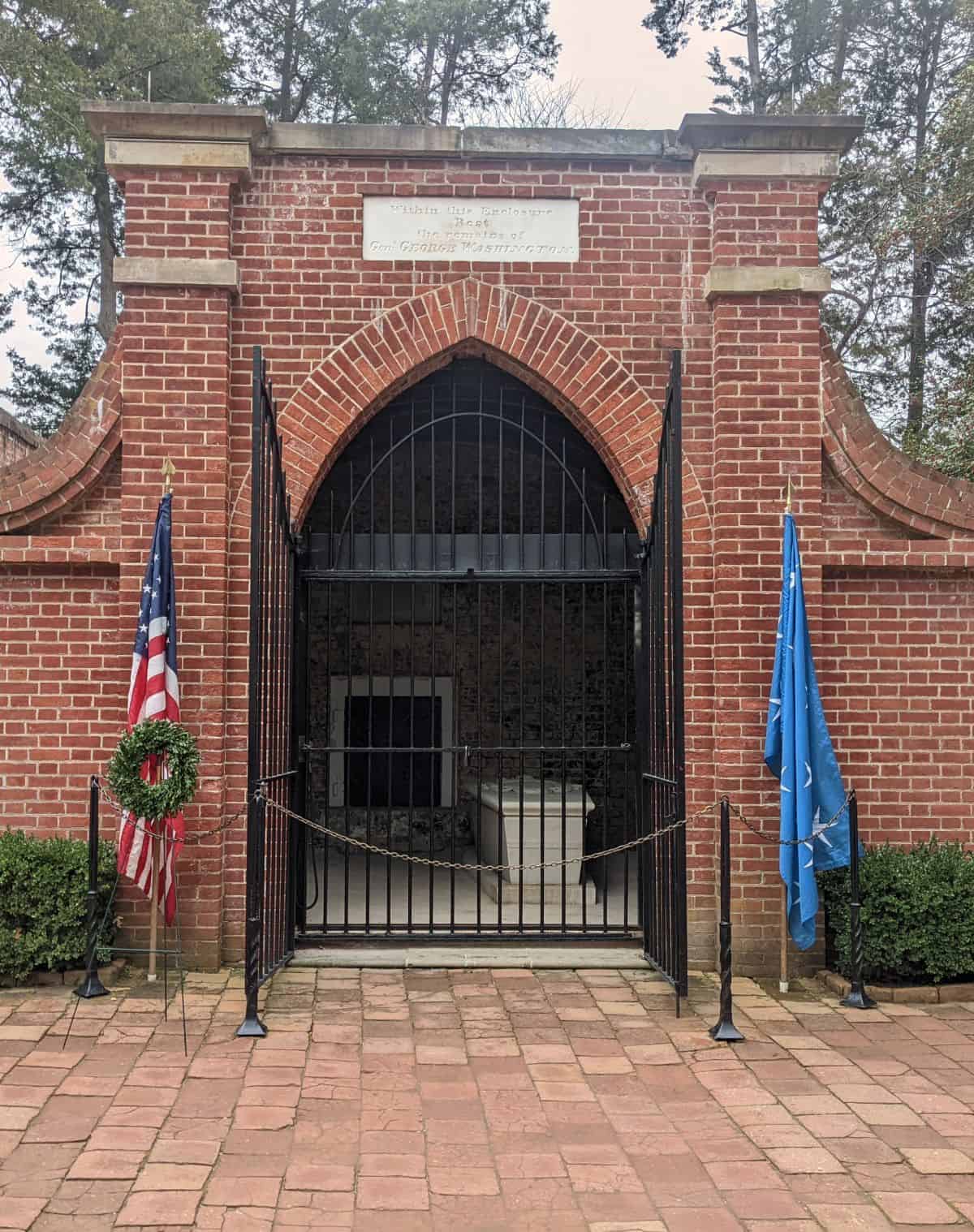
While you’re at Mount Vernon, I recommend you stop at the final resting place of George and Martha Washington. Well, there are actually two tombs. In his will, Washington directed the construction of a new tomb at Mount Vernon.
Washington was moved from his original burial place (still on the property) to the large “new” tomb in 1830 along with Martha Washington and other family members.
Slave Memorial
About 50 yards from George Washington’s tomb you’ll find the Slave Memorial . A wreath is laid at the memorial every day to honor those who were enslaved at Mount Vernon.
Several years ago, archeologists began a lengthy survey project to document the final resting places of the enslaved people who died while at Mount Vernon. There will be no excavations, but there are plans to thoroughly map the area of the slave cemetery.
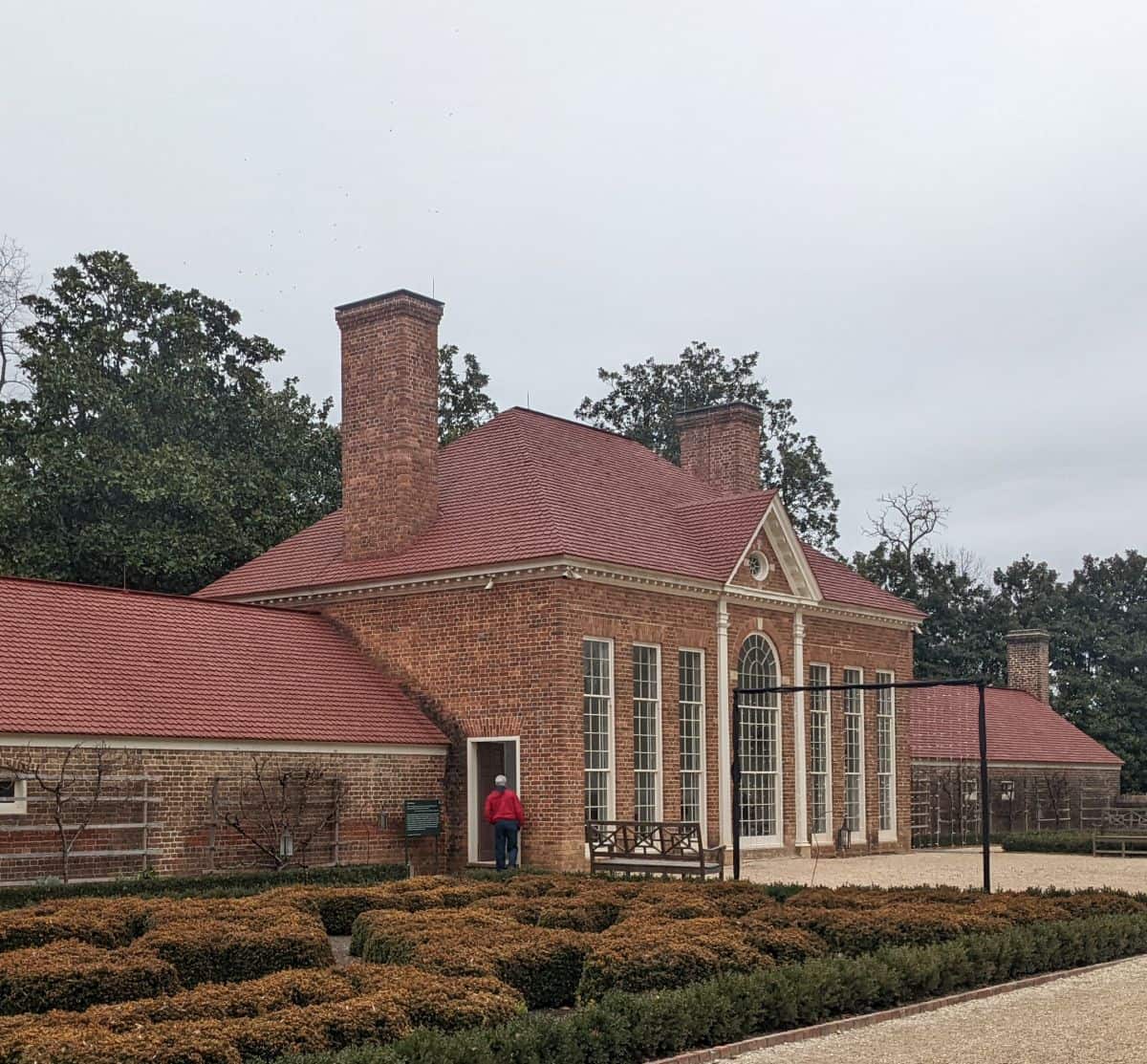
George Washington was known for his love of gardening, and the gardens at Mount Vernon are a testament to that passion.
There are four gardens on the estate: the lower garden, the upper garden, the botanical garden, and the fruit garden and nursery. All are filled with beautiful flowers, plants and trees, and offer visitors a chance to relax and take in the natural beauty of Mount Vernon.
The upper garden includes a beautiful greenhouse.
The lower garden was the estate’s kitchen garden, which grew the food that was prepared for the Washington household. This garden was really Martha Washington’s domain rather than George Washington’s.
The botanical garden was kind of a place for horticulture experimentation.
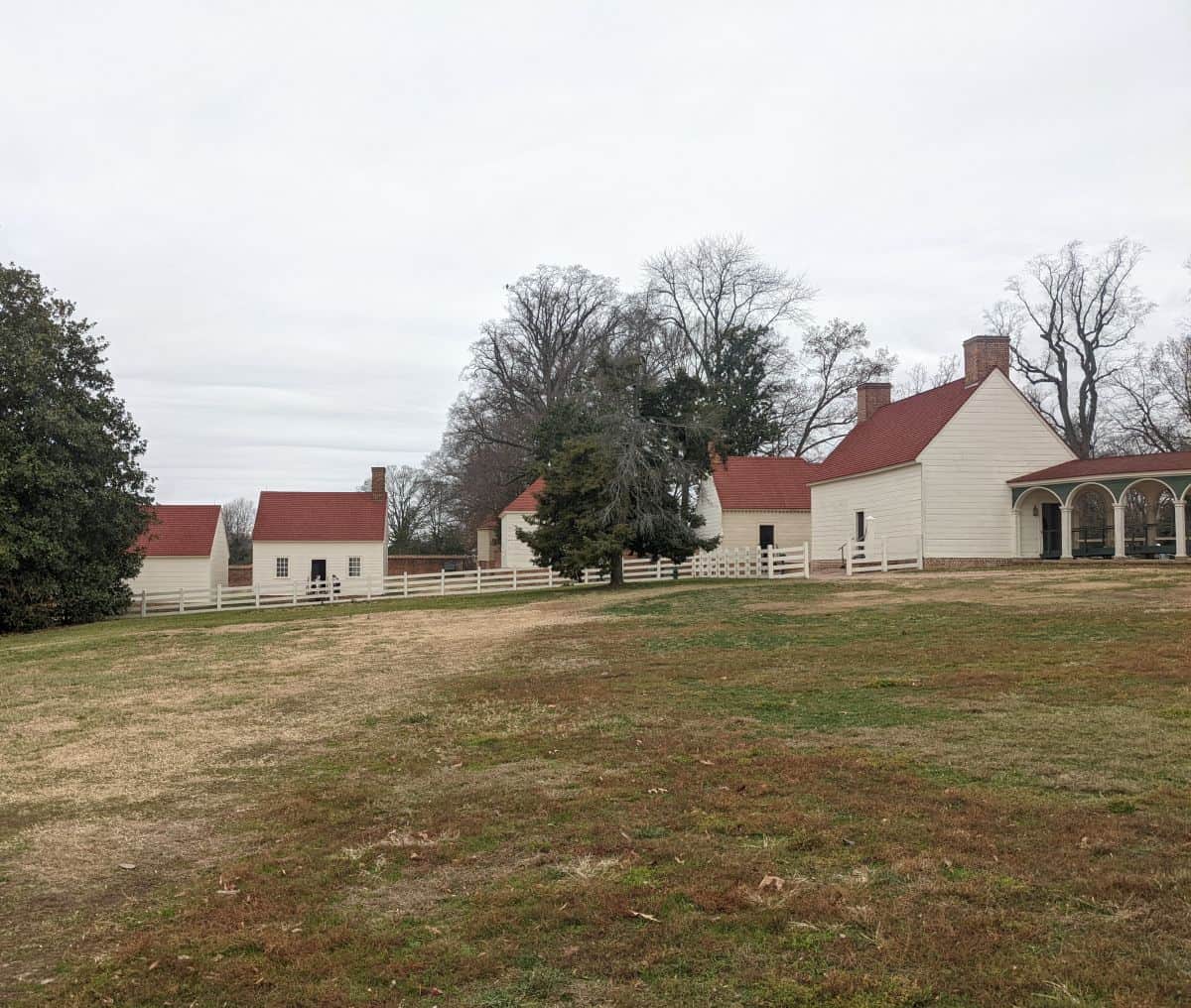
Historic area outbuildings
Explore the outbuildings in the Mount Vernon historic area to learn more about the skills that were needed to maintain the estate.
You can see the blacksmith shop, smokehouse, stable, and spinning house among other outbuildings. The buildings, which date back to the 18th century, offer a glimpse into life at Mount Vernon during Washington’s time.
Education Center
If after doing all of the above, you still have time and energy to learn more about George Washington and Mount Vernon then stop by the Education Center.
The education center offers a 4D theater experience and a variety of hands-on exhibits that provide in-depth information about Washington’s life and career. You’ll also find exhibits on the estate itself, as well as the history of slavery in America.
There are several films available at both the Education Center and the Orientation Center (see above). I wouldn’t recommend you spend too much time watching films if it’s your first time at Mount Vernon.
Perhaps choose one or two that appeal to you. Then spend the bulk of your time exploring the estate itself.
Please note: the Education Center exhibit on George Washington’s Life will undergo a rebuild from July 2024 through 2025.
Where to eat at Mount Vernon
Mount Vernon offers a Food Court Pavilion and a restaurant for when you’re ready to pause and enjoy a bite to eat.
The Mount Vernon Food Court is where to go to grab a quick meal or snack. They offer things like salads and sandwiches, plus they’re open for breakfast.
We enjoyed dining at the Mount Vernon Inn Restaurant . They offer lunch and dinner menus, plus weekend brunch.
If you want to eat at the Inn Restaurant, I recommend making advance reservations. But if they aren’t taking reservations you can inquire at the hostess stand to see if they can fit you in.
It’s important to note that no outside food or beverages are allowed on the grounds of Mount Vernon except water. There are a few tables available in front of the gift shop for those who want to bring a sack lunch.
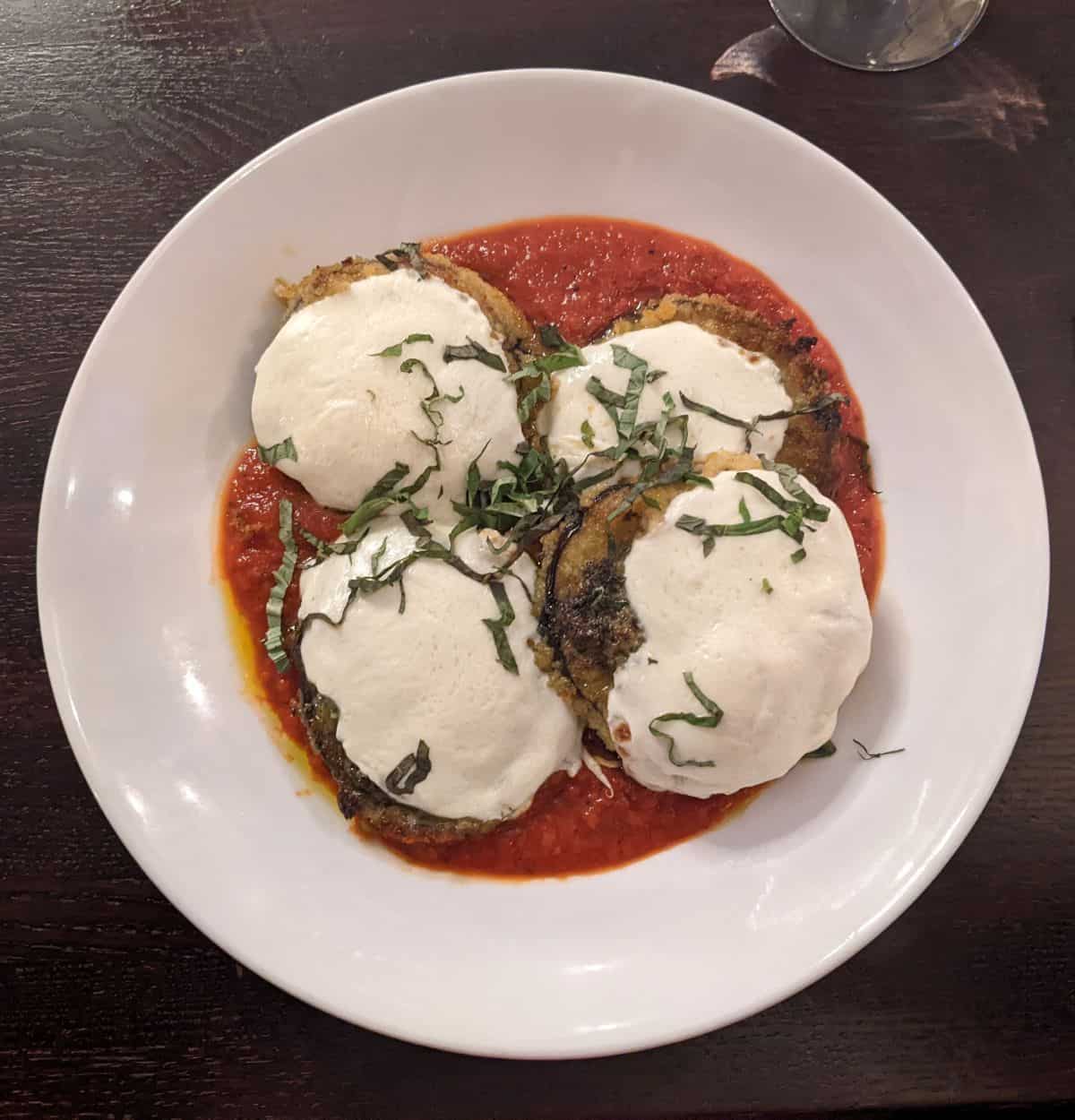
Where to stay when visiting Mount Vernon
If you’re looking for a place to stay while visiting Mount Vernon, Alexandria, Virginia, is a great option. Alexandria is just a few miles from the estate, and there are plenty of hotels and restaurants in the city. Plus, Alexandria offers plenty of attractions of its own, so you can easily fill a day or two when you’re not touring Mount Vernon and make a weekend getaway out of it.
We stayed at the Residence Inn by Marriott Alexandria Old Town South at Carlyle and had a fine stay in a quiet area.
Here are a few other highly rated options in Alexandria:
- The Westin Alexandria Old Town : just a few blocks from the King Street metro station. They also offer exclusive concierge service and an on-site restaurant.
- Hotel Indigo Old Town Alexandria : only a 3-minute walk to the Old Town Waterfront and just five miles from Ronald Reagan Washington National Airport.
Final thoughts on touring Mount Vernon
Washington’s home is full of amazing history and beautiful scenery, and there’s something for everyone. Whether you want to explore the mansion, stroll through gardens, learn about George Washington the man, or just relax by the river, Mount Vernon has something special waiting for you.
Make sure to plan your visit ahead of time so you can make the most of your time at this iconic American landmark!
Are you planning a visit to Mount Vernon? What are you looking forward to most?
More articles related to visiting Mount Vernon
- The top day trips in Virginia
- Day trips from Washington, DC
- Guide to visiting Thomas Jefferson’s Monticello
- What to see and do at James Madison’s Montpelier
- The essential day bag packing list
Pin this post!
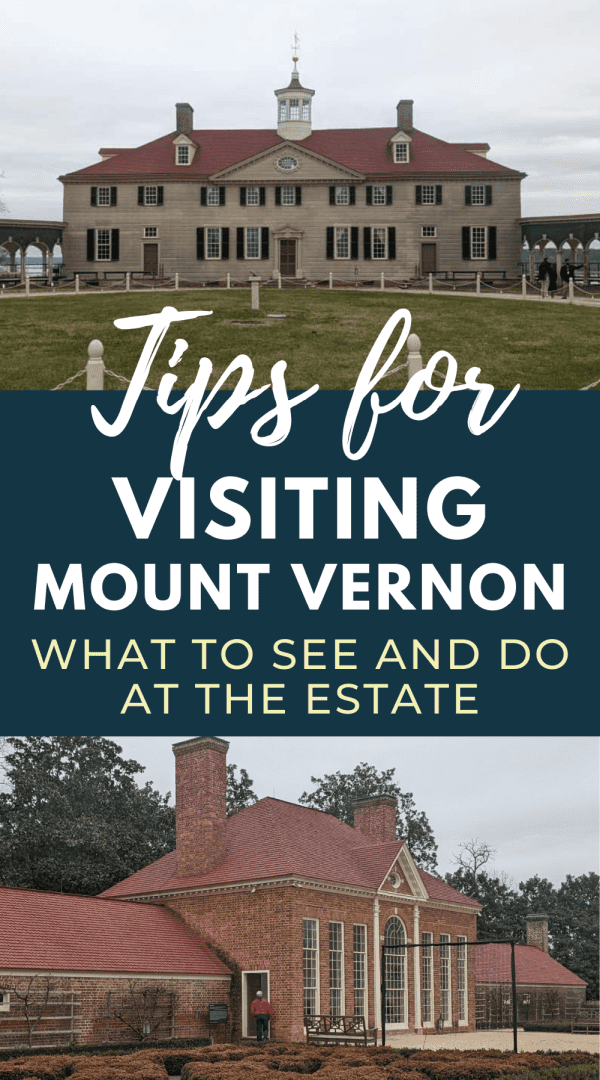
Darcy Vierow is a busy professional and travel planning expert with years of experience maximizing travel with limited time and on a less-than-average salary. Her tips have been published by Forbes, MSN.com, Yahoo! News, Yahoo! Finance, Aol, Newsbreak and GOBankingRates. Read more about Darcy Vierow .
Leave a Reply Cancel reply
Your email address will not be published. Required fields are marked *
By using this form you agree with the storage and handling of your data by this website. *
Privacy Overview
Historic Preservation at Mount Vernon
Timeline historic preservation at mount vernon.
Mount Vernon’s journey from being the beloved home of the first president to a landmark of national significance is the story of foresight and perseverance—and one that puts it at the forefront of the American preservation movement.
George Washington Dies
Two years after serving as the first president of the United States, George Washington dies at age 67 on December 14. By the terms of Washington’s will, the first president grants his wife Martha “the use, profit and benefit of my whole Estate, real and personal, for the term of her natural life.”

A Shrine of Remembrance
George Washington is remembered and revered across the United States. Visitors flock to Mount Vernon, where extended Washington family receive those who wish to see where the illustrious general, president, and founding father lived and is buried.

Martha Washington Dies
Martha Dandridge Custis Washington dies at age 70 at Mount Vernon.

Bushrod's Ownership
Mount Vernon ownership, including the Mansion and approximately four thousand acres of surrounding land, transfers to Washington’s nephew, Supreme Court Justice Bushrod Washington. Unfortunately, Bushrod did not share his uncle's passion or skill for farming, and the estate began to fall into disrepair. Sightseers also contributed to the physical decline of the Mansion and the surrounding grounds.

Independence Hall
Following the transfer of Pennsylvania’s state capital to Lancaster in 1799, Independence Hall is threatened by development. The city of Philadelphia purchases the landmark to save it from demolition.

Death of Bushrod
Bushrod Washington dies, having made modifications to the Mansion (including a porch on the south façade and balustrade to the piazza roof) and erecting a host of structures on the landscape (including porters’ lodges at the west gate entrance and a gazebo on the east lawn). His nephew, John Augustine Washington II , inherits Mount Vernon.

The New Tomb
In accordance with Washington’s will, a new family burial vault is completed, and Washington’s body, along with the remains of Martha Washington and other family members, is transferred to the New Tomb.

Jane Charlotte Blackburn Washington Ownership
John Augustine Washington II dies, passing ownership of Mount Vernon to his wife Jane Charlotte Blackburn Washington.

Greenhouse Fire
A tremendous fire devastates Washington’s greenhouse and a portion of the enslaved living quarters.

John Augustine Washington III
John Augustine Washington III begins leasing Mount Vernon from his mother Jane Charlotte Blackburn Washington.
John Augustine Washington III formally takes ownership of Mount Vernon. Though John Augustine was a motivated farmer, Mount Vernon's total acreage shrank to roughly 1,200 acres from a height of 8,000 acres during George Washington's lifetime, and the remaining farmland is not enough to adequately sustain the Washingtons. John Augustine eventually reversed Bushrod's decision to ban steamboats and entered into a contract with a company that provided regular trips from Washington, D.C., three days a week.

Mount Vernon Ladies' Association
Ann Pamela Cunningham of South Carolina founds the Mount Vernon Ladies’ Association (MVLA) with the intention to purchase Mount Vernon from John Augustine Washington III in order to preserve George Washington’s residence and to prevent its sale to land speculators. The MVLA becomes the nation’s first historic preservation organization, as well as one of the first national women’s organizations.

Purchasing Mount Vernon
John Augustine Washington III finds he is financially unable to maintain Mount Vernon given the demands of upkeeping the tourist destination. The now-iconic piazza is recorded to be supported by makeshift wooden posts. After soliciting the U.S. government and the Commonwealth of Virginia for support, Washington agrees to sell the Mansion and 200 acres of surrounding land to the MVLA for $200,000.

On George Washington’s 128th birthday, February 22, the MVLA takes possession of the Mount Vernon estate. The effort represents the first campaign to preserve a former president's home, as well as the first to preserve an entire site (outbuildings, landscapes, and vistas) and not just the home.

Original Artifacts
John Augustine Washington III leaves behind a handful of original objects, including Jean Antoine Houdon’s famous lifelike sculpture of George Washington.

Ann Pamela Cunningham and her secretary, Sarah Tracy, take up residence and are joined by Upton Herbert, who is hired as superintendent and charged with executing the most critically needed repairs.

Demolition of Hancock Manor
Hancock Manor, the home of John Hancock, is torn down in Boston. This event galvanizes early historic preservation efforts in the Northeast and begins the impetus for the modern historic preservation movement.

The Civil War Concludes
Mount Vernon remained preserved during the conflict, thanks in part to Union and Confederate forces agreeing to restrict fighting at the estate and laying down their arms when touring the property.

Furnishing the Mansion
The Vice Regent for New Jersey from 1868 until 1891, Nancy Wade Halsted challenged the Ladies to furnish each room in the Mansion. Eighteenth-century pieces were to be used wherever possible, with more recent Greek Revival and Victorian furnishings filling the gaps. Many decades would pass before the Association could furnish all rooms with original Washington pieces or very similar examples.

Paint Pioneers
The Mount Vernon Ladies' Association becomes the first preservation society to use paint reveals in order to identify original paint colors in the Mansion.
Earliest Photograph of MVLA
Twelve founding Ladies of the Association, representing their home states, pose on the piazza with the famous Houdon bust of George Washington. Miss Cunningham, first Regent of the Ladies' Association, is seated to the right of the bust. The other ladies pictured are Vice Regents in the Association's governing council, a structure still in place today.

First National Park
Congress and President Ulysses S. Grant create Yellowstone National Park, the first federal action to protect resources, natural or historic, for the public good.

Ladies, the home of Washington is in your charge; see to it that you keep it the home of Washington. The Mansion and the grounds around it should be religiously guarded from change—should be kept as Washington left them. Let no irreverent hand change it; no vandal hands desecrate it with the fingers of progress. Those who go to the home in which he lived wish to see in what he lived and died.”
Superintendent Dodge
Colonel Harrison Howell Dodge begins his lengthy tenure (1885 – 1937) as Mount Vernon’s third resident superintendent and ushers in an era of extensive preservation efforts.

Preservation Virginia Founded
Mary Jeffery Galt reacts to the loss of Powhatan’s Chimney—a surviving chimney stack purported to belong to a house built by John Smith at the site of Werowomoco—by founding the Association for the Preservation of Virginia Antiquities (APVA, now Preservation Virginia).

Vice Regent Hearst
Phoebe Apperson Hearst served as Vice Regent for California from 1889 to 1918. Mrs. Hearst was an especially generous contributor to the Mount Vernon cause, funding construction of a stone wall along the river shore to protect against erosion, and supporting the installation of Thomas Edison's electrical system.

Washington's Coach House
Elizabeth A. Rathbone, Vice Regent from Michigan, raises funds in her home state for the reconstruction of Washington’s coach house. The building, which stood at the end of the south lane by April 1776, disappeared from the landscape between 1855 and 1858. Excavation uncovers the original foundations, which are repaired; oral tradition passed down by “old servants” allows Colonel Dodge to reproduce it “practically.”
This effort, along with the 1860 reconstruction of the spring house, represents the first instance of a preservation society reconstructing missing 18th-century buildings based on surviving evidence.

Antiquities Act
President Theodore Roosevelt signs the Antiquities Act of 1906, providing the president with the power to create national landmarks. This is the first major effort on behalf of the federal government to preserve buildings and land for the public interest.

Regent Comegys
Harriet Clayton Comegys of Delaware served as Regent from 1909 until 1927. During her tenure, the gardens and grounds were given greater attention than ever before, marking the first concerted attempt to recapture their appearance during George Washington's lifetime.

Historic New England Founded
The Society for the Preservation of New England Antiquities (now Historic New England) is established.

National Park Service
The National Park Service is established; historic and natural sites of significance are acquired by the federal government for public visitation and use. Sites connected with George Washington are among early preservation initiatives, and the first national historic park, Washington’s wartime headquarters in Morristown, New Jersey, is designated in March 1933.

Edison Electrifies Mount Vernon
Recognizing that candles and kerosene lamps pose a fire hazard to George Washington’s wooden Mansion, the MVLA considers the proposal of inventor Thomas Edison to install electricity in the Mansion. Concerns for the long-term preservation of the historic building outweigh those of authenticity, and the MVLA approves Edison’s plan.

Mount Vernon Fire Department
Henry Ford visits Mount Vernon and is alarmed to discover that George Washington’s wood-frame buildings are not adequately protected from fire. Ford donates the MVLA’s first fire engine—a built-to-order American-Lafrance Combination Chemical and Hose Car. Ford also encourages the MVLA to establish a fire department, and the MVLA subsequently provides housing and equipment for an onsite employee fire team. The Ford Motor Company continues to provide vehicles for Mount Vernon's motor fleet and has sponsored many educational programs, facilities, and traveling exhibits.

Preservation of Williamsburg
John D. Rockefeller, Jr., begins funding the restoration of Williamsburg, Virginia. At first acting anonymously, Rockefeller eventually funds the preservation of more than 80 original buildings.

Booming Visitation
Annual visitation to Mount Vernon exceeds 500,000 for the first time.

George Washington Memorial Parkway
After President Calvin Coolidge establishes the George Washington Bicentennial Commission in 1924, construction begins on the Mount Vernon Memorial Highway, the first scenic parkway to be built and maintained by the U.S. government. Later renamed the George Washington Memorial Parkway, the highway is completed in time for the bicentennial of Washington’s birth in 1932.
Slave Cemetery Marker
The Mount Vernon Ladies’ Association places a commemorative marker noting the site of the 200-year-old slave cemetery at Mount Vernon. We believe this marker to be the earliest of its kind on a historic plantation. Despite this official recognition, the burial ground lies unattended in dense underbrush for years.

Morley Jeffers Williams
Morley Jeffers Williams, an engineer and landscape architect, is hired by the MVLA. Over the next 9 years, he oversees the removal from the Mansion of a post-Washington-era porch on the south side (1932), the removal of a balustrade atop the piazza (1936), and undertakes the first systematic archaeological excavations at Mount Vernon.

Washington's Gristmill
In support of the bicentennial of Washington’s birth, the Commonwealth of Virginia constructs a replica of George Washington’s Gristmill after extensive archaeological efforts relocated the foundation of the original mill.

Historic American Buildings Survey
Charles Peterson establishes the Historic American Buildings Survey (HABS) within the National Park Service. Teams nationwide compile an irreplaceable record of the country’s rapidly disappearing early architectural heritage.

Historic Sites Act
Congress passes the Historic Sites Act “to preserve for public use historic sites, buildings, and objects of national significance for the inspiration and benefit of the people of the United States.” The act is the first assignment of historic preservation as a government responsibility and makes permanent the HABS.
Restoring the Mansion
The Ladies’ Association decides to preserve Mount Vernon as it appeared in 1799, the year of George Washington’s death. This required that a 19th-century balustrade, visible in this image on the roof of the piazza, be removed in 1936.

Reconstructed Greenhouse and Slave Quarters
The MVLA reconstructs George Washington’s greenhouse and slave quarters complex, which burned in 1835. The structure incorporates 18th-century materials from a number of demolished structures in the region, most notably bricks salvaged from the original White House.
In 1962, one interior bunkroom is refurnished and opened to the public, one of the nation's first interpretations of an enslaved dwelling space.

Preserving Washington's View
Frances Payne Bolton, Vice Regent for Ohio, purchases nearly 500 acres of Maryland shoreline across the Potomac River from Mount Vernon in order to prevent commercial development within George Washington’s view. Along with concerned stakeholders, Bolton’s acquisition galvanizes support for land conservation to preserve the viewshed, leading to the formation of Piscataway Park and continued preservation of Mount Vernon’s eastern vista. The achievement represents the first national park to be established to preserve a historic vista, as well as a precedent-setting example of private-public partnership for land conservation.

National Historic Landmark
The National Park Service initiates a limited register of National Historic Landmarks, the precursor of the National Register of Historic Places. Mount Vernon is added in October 1966.

Visitation Landmark
Mount Vernon visitation reaches an all-time high of 1.3 million.
National Historic Preservation Act
Congress passes the National Historic Preservation Act in response to the Federal Aid Highway Act of 1956 and the Urban Renewal Program of the early 1960s, both of which brought about unprecedented loss of historic resources in America’s cities, culminating in the demolition of New York’s Pennsylvania Station in 1963.

Paint Analysis
Mount Vernon becomes one of the first historic houses to undertake a comprehensive campaign of microscopic paint analysis. Matthew Mosca takes nearly 2,500 paint samples throughout the Mansion to determine the 18th-century paint finishes of the rooms. Over a two-year period, the Mansion was completely repainted according to the findings

Howard University Memorial
Howard University architecture students design a memorial to the enslaved individuals buried at Mount Vernon’s slave cemetery. A cooperative effort between Black Women United for Action and the MVLA, the memorial raises greater awareness of the impact of plantation slavery at the home of the first president, resulting in ongoing efforts to educate the public about Washington’s conflicted relationship with slave ownership.

Early Archaeology
The MVLA asks the Virginia Department of Historic Landmarks to conduct a one-year archaeological survey of the 424-acre estate. The rediscovery of the House for Families, an early Washington-period slave quarter, and blacksmith shop prompts the MVLA to consider a cultural resource program similar to those run at other plantation sites and Colonial Williamsburg.
At the time, the excavation of the House for Families resulted in the largest assemblage of material evidence of an enslaved community in the Chesapeake region.

Archaeology Program
Mrs. Clinton M. Bockstoce, Vice Regent for Connecticut, donates funds to establish a permanent archaeology program at Mount Vernon. This action provides permanent operating funds for a research division at Mount Vernon, which had been absent since 1939. The department is expanded in 1994 to include full-time staff dedicated to architectural conservation, as well as research.

Wharf Dedication
Queen Elizabeth II and Mabel Livingstone Bishop, Mount Vernon's Regent, preside at the re-dedication of the wharf at Mount Vernon. Restoration of the wharf, built by the Ladies' Association in 1860 near the site of one of George Washington's original landings, was supported by donations from citizens of Oregon, the Regent's home state.

Washington Farm
The four-acre Washington Farm is opened at Mount Vernon, inviting guests of all ages to learn more about Washington's progressive agricultural practices. The Farm represents the more than 3,000 acres Washington cultivated during the second half of the 18th century.

Mansion Roof
The Mansion roof is replaced with shingles hand-split from old-growth cypress logs that had sunk more than a century ago in the swamps of Florida. Washington purchased hundreds of thousands of cypress shingles for Mount Vernon during his lifetime. The red color used on Mount Vernon's roofs today was matched to the paint preserved on an original shingle found in the Mansion attic, apparently dropped during shingle replacement in the 1800s.

16-Sided Treading Barn
George Washington designed an innovative 16-sided barn to streamline the time-consuming processing of wheat. In 1870 the treading barn was near collapse. Mount Vernon's carpenters completed a replica and opened it to visitors in 1996, after five years of intensive research and construction. Major support was provided by the W.K. Kellogg Foundation. Today, the barn is the centerpiece of Mount Vernon's four-acre Washington Farm.

Dung Repository
Based on historical documents and two years of archaeological excavation, Washington’s “Repository for Dung” is reconstructed, incorporating remnants of the original brick foundation walls and the virtually intact cobblestone floor. Originally erected in 1787, the structure was designed to compost animal droppings and other organic waste for use as fertilizer in the nearby gardens and orchards. It is thought to be the first structure in the nation specifically designed for composting.

Operational Gristmill
Having acquired the reconstruction of Washington’s Gristmill from the Commonwealth of Virginia in 1997, Mount Vernon completes a five-year restoration to return the gristmill to operational status.

National Humanities Medal
President George W. Bush presents the coveted National Humanities Medal for service to the nation to the Mount Vernon Ladies' Association.

Washington's Distillery
A reconstruction of George Washington’s Distillery, rebuilt as close as possible to its original specifications, is completed after 9 years of historical and archaeological research. These efforts were supported by the members of the Distilled Spirits Council of the United States. Originally created in 1797, the Distillery produced nearly 11,000 gallons just two years later, making it one of the largest whiskey distilleries in America. Although the Distillery building burned in 1814, archaeological excavations uncovered its stone foundation, the location for the five stills and boiler, numerous underground drains, and evidence for the wall that separated the storeroom and office.

Replica Slave Cabin
Mount Vernon opens a replica slave cabin at the Washington Farm site, based on an early 20th-century photograph. This replica structure shows the conditions under which much of Mount Vernon's enslaved laborers lived.

Blacksmith Shop
A reconstruction of the Blacksmith Shop, built on its original site, is completed. An excavation by Mount Vernon’s archaeologists, along with period paintings and other primary sources, provided valuable clues about the structure’s design. The Blacksmith Shop was essential to the running of the plantation and vital to Washington’s business endeavors. Records indicate that as early as 1755 a blacksmith shop was located along the north lane, about 200 feet from the Mansion.

Greenhouse Slave Quarter
The greenhouse slave quarter is refurnished based on ongoing research and an additional bunkroom opens to visitors.

Upper Garden
The Upper Garden is reopened to guests after considerable archaeological and historical investigation.

Department of Historic Preservation and Collections
The Department of Historic Preservation and Collections is established, uniting all preservation efforts at Mount Vernon, including the archaeology, architecture, fine and decorative arts, horticulture, and livestock collections and programs.

Digitizing Mount Vernon
Mount Vernon develops a cutting-edge prototype for a Historic Building Information Management (HBIM) system, a digital tool to understand how George Washington’s iconic Mansion was created and has evolved over time through renovations, additions, and repairs.
In 2015, this project won Mount Vernon a Special Achievement in GIS (SAG) Award.

The New Room
The Mansion’s New Room is meticulously restored, reviving the original grandeur of the space that George Washington spent years designing.

George Washington Presidential Library
More than 200 years after the general wrote of his dream for a library, the Mount Vernon Ladies' Association completes the George Washington Presidential Library at Mount Vernon. The 45,000-square-foot facility safeguards original books and manuscripts according to the highest standards.

Archaeology at the Slave Cemetery
Mount Vernon archaeologists begin the excavation of the plantation’s slave cemetery, located in close proximity to George Washington’s tomb. They leave the remains of the enslaved undisturbed and use ground-penetrating radar as well as topsoil excavations to identify the location, size, and outline of the cemetery’s grave shafts. By 2022, archaeologists identify 86 graves of the enslaved men, women, and children who lived and worked on the property prior to 1860.

Database of the Enslaved
Mount Vernon establishes a database compiling all references to enslaved people at Mount Vernon and other Washington properties. More than 900 individuals have been identified, with more than 500 at Mount Vernon.

Lives Bound Together
The in-house exhibit Lives Bound Together: Slavery at George Washington’s Mount Vernon opens, exploring the personal stories of the people enslaved at Mount Vernon while providing insight into George Washington’s evolving opposition to slavery.

Chintz Room
After more than two years of intense forensic investigations, documentary and material culture research, conservation, and restoration, one of Mount Vernon’s major bedchambers, the Chintz Room, is reopened for viewing. Located on the second floor in the southwest corner, the Chintz Room was one of the finest of the six primary bedchambers at Mount Vernon.

The Blue Room, a second-floor bedchamber worthy of distinguished guests in Washington’s time, is restored after extensive research by Mount Vernon's Historic Preservation & Collections team.

Front Parlor
After a multi-year restoration project, George and Martha Washington's Front Parlor is reopened to the public. Once a site of formal entertainment, the Front Parlor was rejuvenated with the assistance of architectural forensic analysis and significant documentary discoveries.
Yellow Room
Historic Preservation & Collections staff complete a partial restoration of the Yellow Room, relying on updated paint analysis, a careful study of the Washingtons’ papers, surviving original objects, and recent material culture scholarship to more accurately represent the appearance and social importance of the room in 1799.

Central Passage
Mount Vernon’s Preservation and Curatorial teams complete a multiyear research and restoration project of the Central Passage, utilizing the latest documentary evidence, paint analysis, and the expertise to present its appearance in 1799. As a result of this work, visitors today experience a brighter, airier space, enlivened by numerous architectural and artistic references to Roman antiquity.

Story of an American Icon
Mount Vernon opens Mount Vernon: The Story of an American Icon. The exhibit follows the evolution of Mount Vernon’s landscape from Native settlements 10,000 years ago, to George Washington’s dramatic overhaul of the house and grounds in the late 18th century, to Ann Pamela Cunningham’s innovative campaign to purchase the property in the 19th century and the MVLA’s efforts to restore Mount Vernon to its 18th-century appearance.

Lafayette Room
Mount Vernon unveils the results of a multi-year project to restore the Lafayette Room to its 1799 appearance. As the largest room on the second floor outside of the Washingtons’ own bedchamber, the Lafayette Room was one of the more desirable guest spaces for 18th-century visitors to Mount Vernon.

Mansion Exterior Restoration Project
Mount Vernon completes the Mansion Exterior Restoration project. Beginning in 2019, this project involved removing 40 years’ worth of paint and sand from the exterior of the Mansion, making repairs to the siding and decorative elements of the east wall and piazza, removing and conserving shutters and window sashes, and applying fresh coats of sand and paint. During the course of this project, Mount Vernon became the first organization to use steam for paint removal on an entire building.

Mansion Revitalization Project
Mount Vernon launches the Mansion Revitalization Project, a landmark, multi-faceted preservation project to safeguard the Mansion’s original building fabric and ensure its structural integrity for generations to come. This includes Designing and installing a new heating/ventilation/air conditioning system (HVAC) for the Mansion, improving drainage in and around the Mansion's cellar, and repairing sections of the Mansion’s framing and masonry. This multi-stage project is anticipated to require at least three years to complete.

See For Yourself
Visit Mount Vernon to explore the legacy of George Washington and to see the ongoing preservation efforts of the Mount Vernon Ladies' Association.
Quick Links
9 a.m. to 5 p.m.

IMAGES
COMMENTS
Mount Vernon is the historic home of America's first president, George Washington, just a short drive from Washington, DC and Alexandria, VA. (12+) $28 (6-11) $15 (0-5) $0 Adults (12+) $28 Youth (6-11) $15 Children (0-5) FREE Buy Your Tickets Online General admission includes one-day admittance to the Mount Vernon estate and an audio tour. While we recommend at least three hours for your visit ...
58. Farms. By Msagro. Schuh Farms always has wonderful vegetables, many things to do like picking out pumpkins, the milk shakes are to die... 5. Little Mountain Park. 86. Lookouts. Little Mountain Parks features two viewpoints that give 180 degree views of north, west and south Skagit Valley to the Olympic Mountains.
Welcome to Mount Vernon. Located on Interstate 5, Mount Vernon is conveniently located mid-way between Seattle, Washington, and Vancouver, British Columbia, Canada. Mount Vernon is a regional hub for agriculture and agritourism, events, entertainment, education and culture, financial and technology, legal, health care, and local government ...
16163 WA-536, Mt Vernon, WA 98273, Phone: 360-428-6894. ... Located right in Mount Vernon, the farm is open from April all through December, so each visit is sure to bring its delights. Dubbed "a kid-riffic place to play," children of all ages will love Schuh Farms' harvest activities. For a small fee, you can participate in the corn maze ...
Magic Skagit Valley. Explore Skagit Valley. Skagit Valley Road Trip! Skagit Farm to Pint Ale Trail. Skagit Valley Weekend - North Cascade Foothills to Deception Pass State Park. Fir Island. Padilla Bay National Estuarine Research Reserve. The Upper Skagit Valley. Guemes Island.
from $69/night. Quality Inn Mount Vernon. 214. from $80/night. Pleasant Ridge Bed & Breakfast. 26. Whispering Firs B&B and Lodge. 36. West Wind Motel.
Mount Vernon. Nestled between the San Juan Islands in the Puget Sound to the West and the Cascade Mountains with the scenic Cascade Loop drive to the East, and only 60 miles from Seattle or 90 miles from Vancouver, B.C., Mount Vernon is a great place to start your adventure in Skagit County. This bountiful city, named 1997's Best Small City ...
1. Roozengaarde Display Garden. 445. Gardens. In 1985, RoozenGaarde was founded as a small showgarden and retail shop. With this addition Washington Bulb Co, Inc. was now able to reach out to the many individual flower enthusiasts and gardeners…. See way to experience (1) 2. Skagit Valley Tulip Festival.
If it piques your interest, then here are some of the best things to do in Mt. Vernon. 1. Take a hike at Little Mountain Park. Little Mountain Park is positioned to the south of Mt Vernon, Washington about 5 mi (8 km) off of the interstate. It has a path that stretches for 2.4 km (1.5 mi) to the top of Little Mountain gaining 284 m (934 ft) in ...
Established in 1889, Mount Vernon is a small city located 60 miles north of Seattle. Most visitors know Mount Vernon as home of the Skagit Valley Tulip Festival, held annually during spring in Skagit County.But there's plenty to do here year-round. Mount Vernon's historic downtown has seen extensive revitalization in recent years — its renovated riverwalk coupled with numerous small ...
Each year, thousands of people visit Mount Vernon and the Skagit Valley to experience whale and eagle-watching, wine tours, tulips, family farms, hiking and other memorable attractions. Tourism in Skagit Valley generates nearly $212 million in revenue. ... 301 W Kincaid St. Mount Vernon, WA 98273. [email protected]. Member login.
George Washington's Mount Vernon is the historic home of George and Martha Washington, located 13 miles south of Washington, DC. Guests can see the historic mansion, stately rooms, and outbuildings preserved to the year 1799, the last year of George Washington's life. Owned and operated by the Mount Vernon Ladies Association, George Washington's Mount Vernon has been visited by world ...
Visit Mount Vernon WA, Mount Vernon, Washington. 1,532 likes · 19 talking about this · 35 were here. Mount Vernon sits at the center of Skagit County, a true slice of Pacific Northwest heaven located...
Mount Vernon is the most populous city in, and county seat of, Skagit County, Washington, United States. A central location in the Skagit River Valley , the city is located 51 miles (82 km) south of the U.S.-Canada border and in between Vancouver , British Columbia (located 80 miles (130 km) to the north) and Seattle (60 miles (100 km) to the ...
Plan your visit for the only Washington Tulip Festival and let the festivities unfold! Explore Events. Festival Faves Our Top Festival Selections for Memorable Moments. ... Mount Vernon, WA 98273. Office Hours: M-F, 10 a.m. - 4 p.m. (May thru March) Open 7 days a week 9am-5pm in April. More Info. Sponsors Poster Artists News Media. About.
Garden Rosalyn features acres of tulips in intricate designs. Enjoy picnic tables and on-site food trucks. Well-behaved dogs on leashes are welcome! Admission is $12 and children five and under are free. Parking is free. Garden Rosalyn is located at 16648 Jungquist Rd, Mount Vernon, WA. You can give them a call at 360-202-7982.
George Washington's Final Resting Place. Since his death at the end of the 18th century, George Washington has been interred in two places at Mount Vernon. Overlooking the Potomac River, the old vault was the original burial plot for POTUS 1, his wife, and 20 other family members. But George Washington realized that the family vault required ...
Mount Vernon is located in northern Virginia, just a short drive from Washington, D.C. For more information about things to do in Virginia, visit Virginia.org, the official tourism website for the state of Virginia.You'll find an overview of each region in Virginia, as well as information about cultural attractions, upcoming events, and where to stay.
Mount Vernon is a historic site located just outside of Washington, D.C. that was home to George Washington, the first president of the United States, and his wife Martha Washington. The estate is managed by the Mount Vernon Ladies' Association. Its preservation and restoration are privately funded. Mount Vernon was first open to the public ...
The ideal applicant will possess a current Washington license/certifcation. This is a RN position in Director. You must have a Current License and at least 2 years of recent experience as a RN - Director. Our Client in Mount Vernon, Washington is committed to providing feedback within 24 to 48 hours upon receving your full submission package.
The Mansion at George Washington's Mount Vernon is one of the most iconic 18th-century homes in America. Reserve your Mansion tour in advance online, as capacity is limited. Due to ongoing preservation work, the Mansion's New Room is not on display. In early Sept. 2024, the New Room, Servants' Hall, and Kitchen will be open.
Travel Nurse RN - OR in Mount Vernon, WA - Excellent Benefits 2024-06-05. TravelNurseSource Mount Vernon, WA. Apply ...
Travel Nurse RN - OR in Mount Vernon, WA - Excellent Benefits 2024-06-05 TravelNurseSource Mount Vernon, WA. Apply. JOB DETAILS. LOCATION. Mount Vernon, WA. POSTED. Today. TravelNurseSource is working with ACES Healthcare Staffing to find a qualified OR RN in Mount Vernon, Washington, 98273!
Yes, Mount Vernon offers free admission to employees of historic homes or museums (with identification). We do not offer discounts for federal government employees or law enforcement. Please call (703) 780-2000 or email [email protected] to request tickets.
The in-house exhibit Lives Bound Together: Slavery at George Washington's Mount Vernon opens, ... Plan Your Visit. Contact Us. 3200 Mount Vernon Memorial Highway Mount Vernon, Virginia 22121 (703) 780-2000 [email protected]. GPS Assistance.